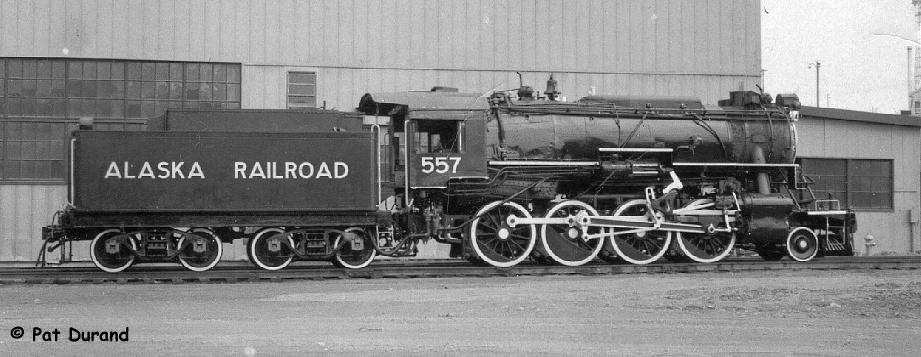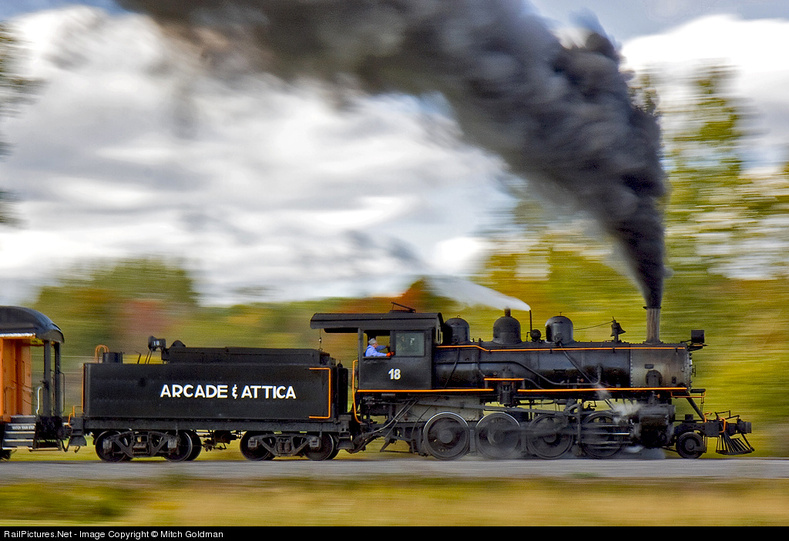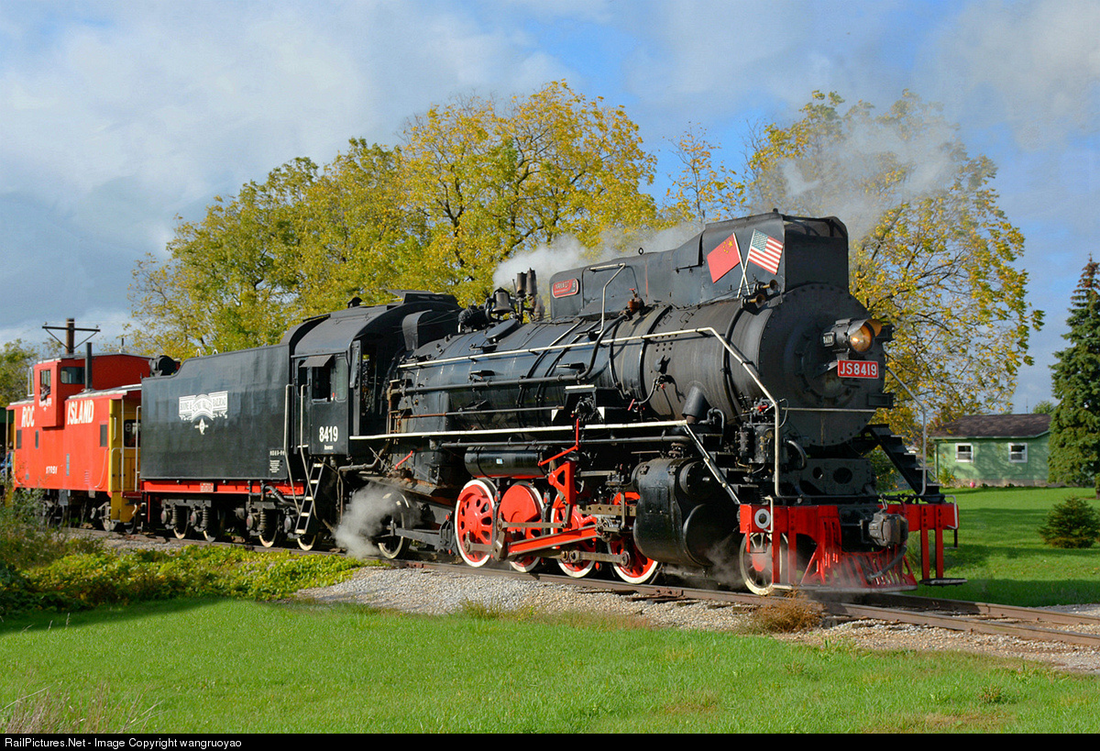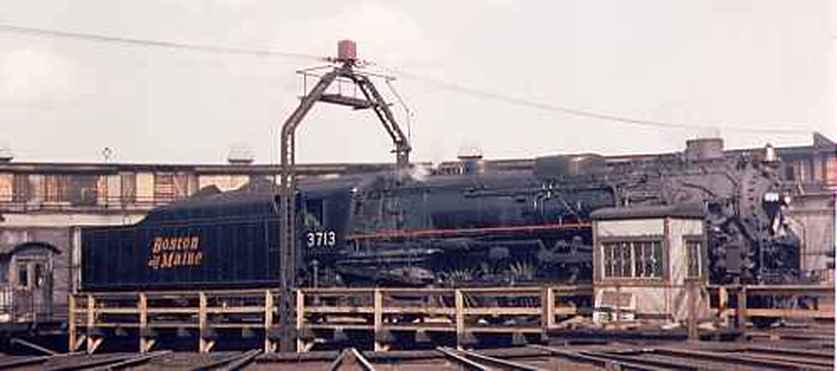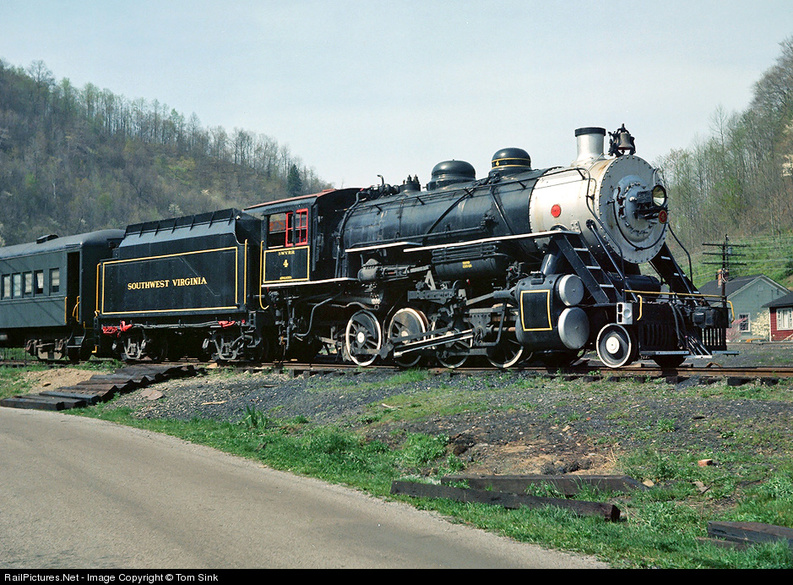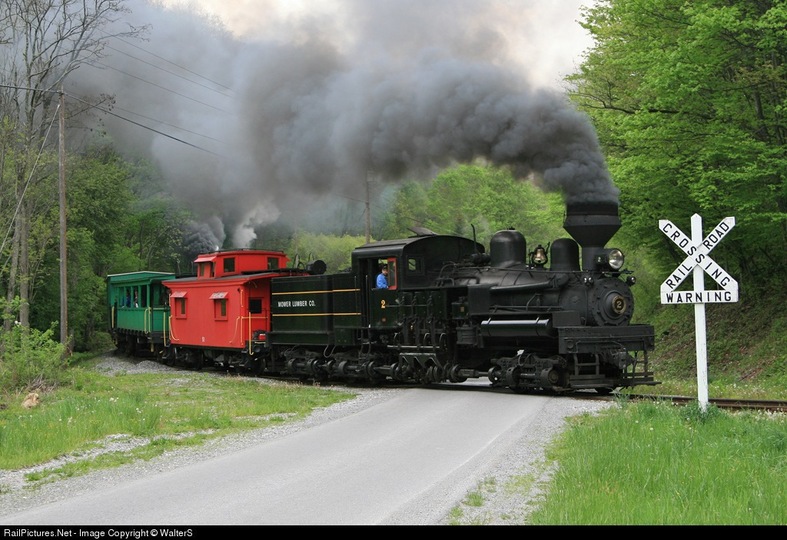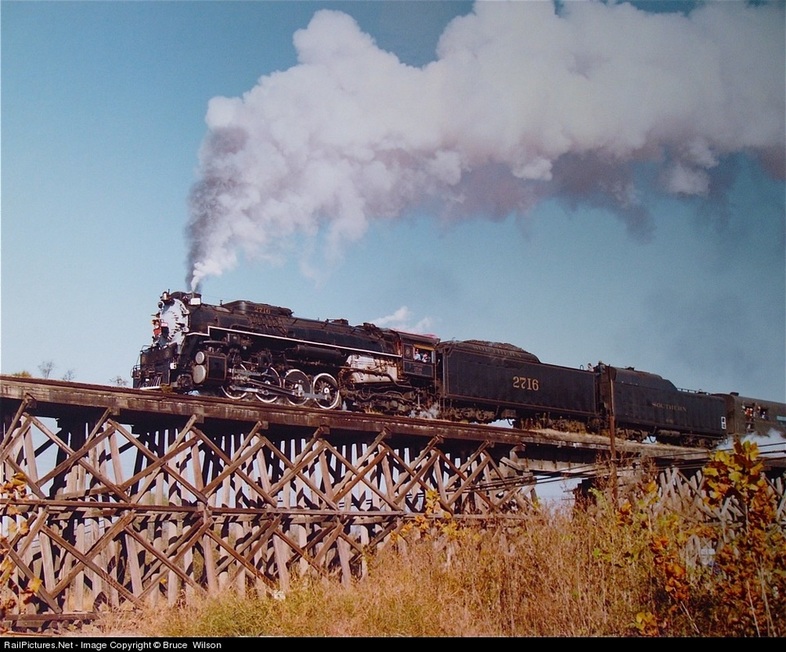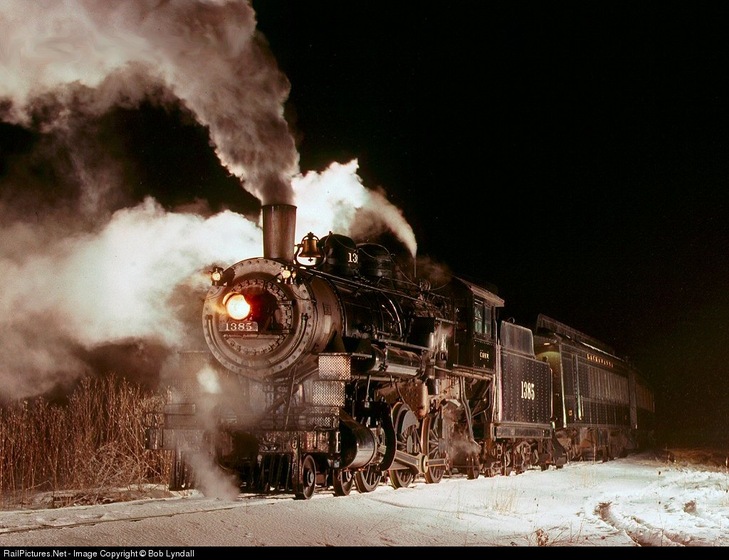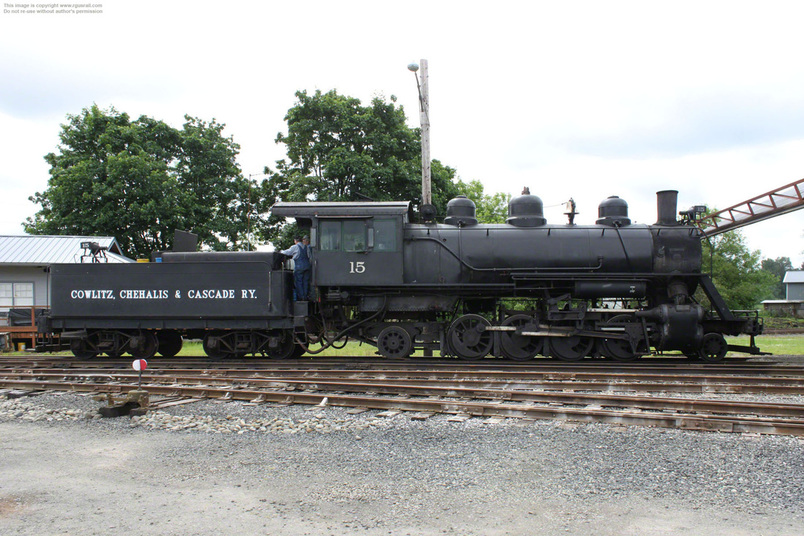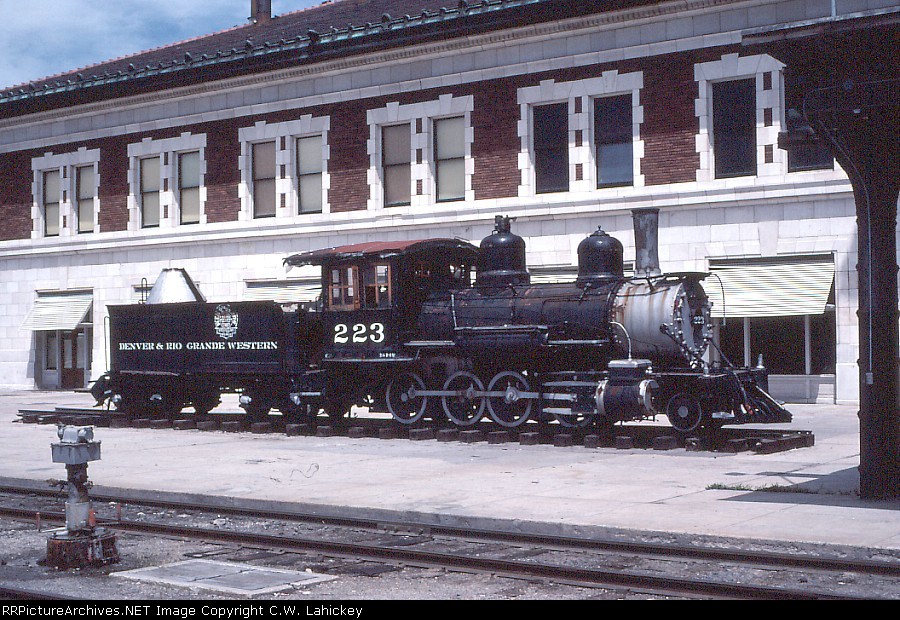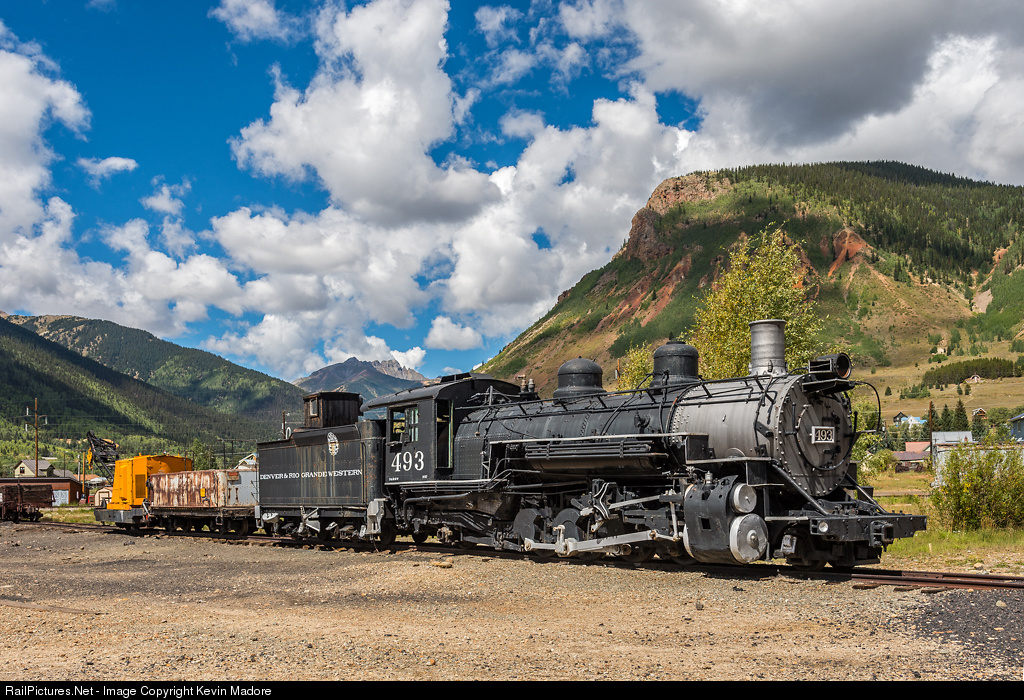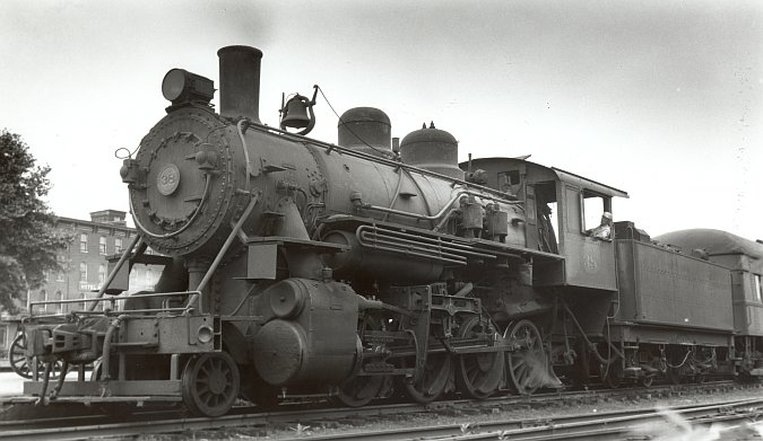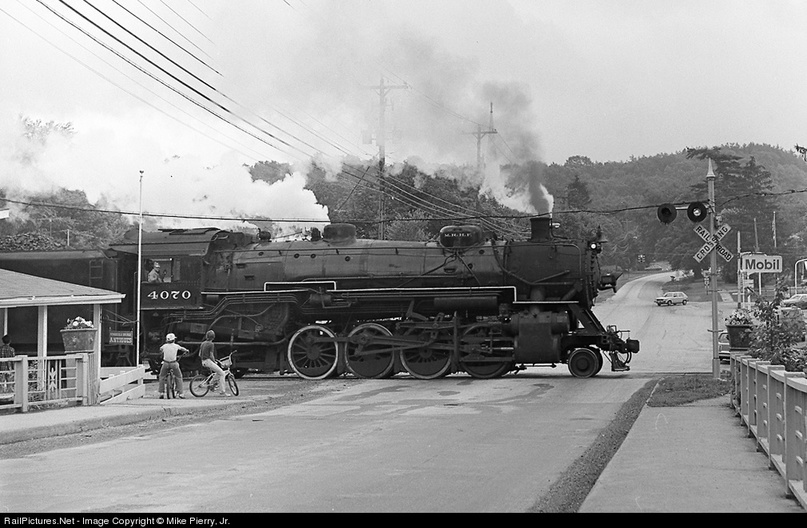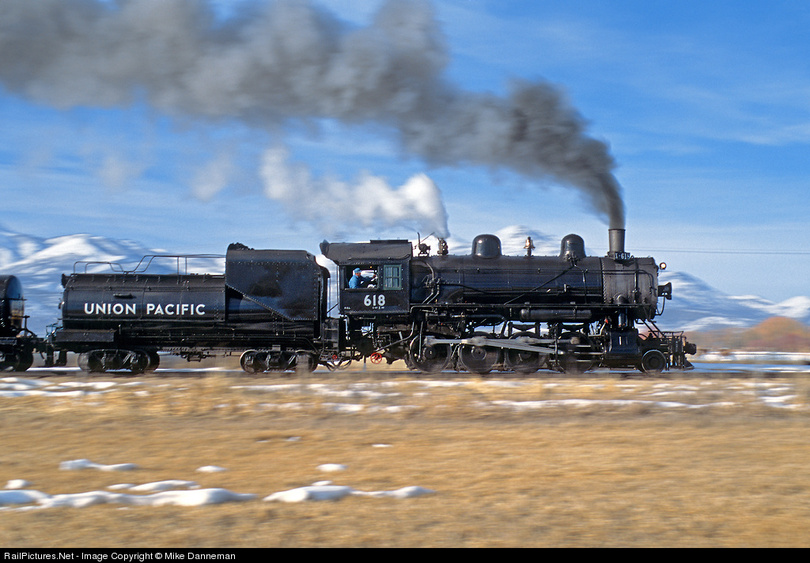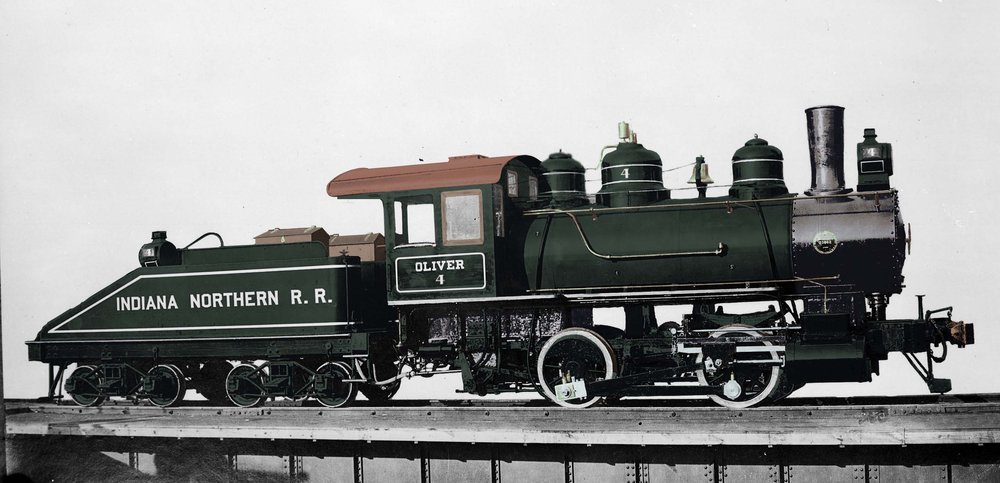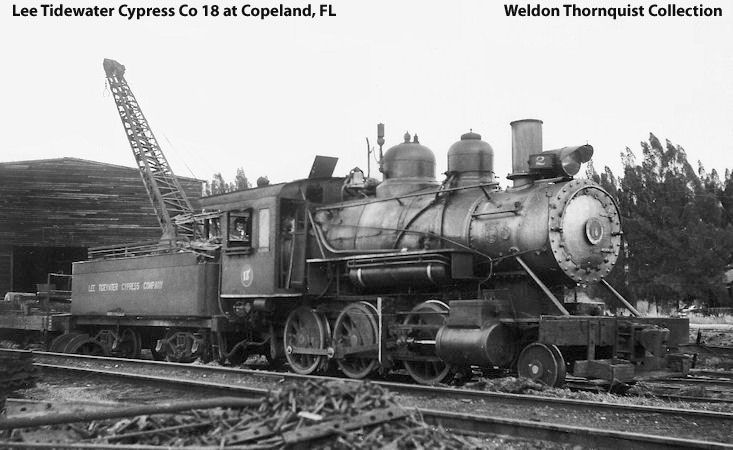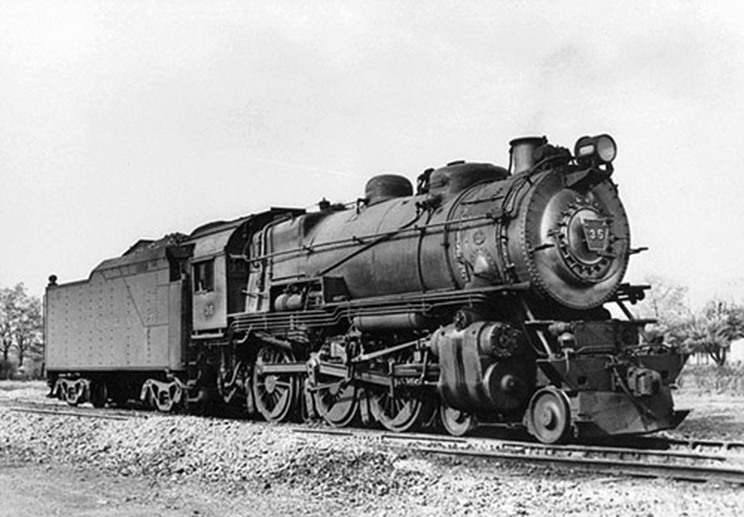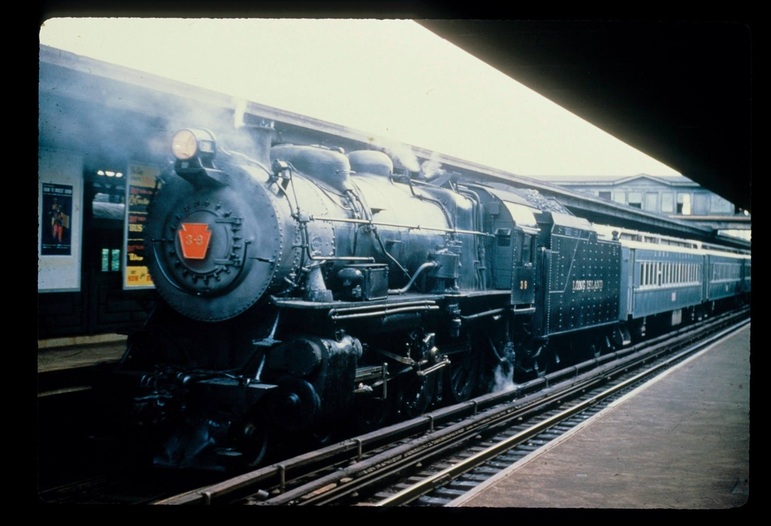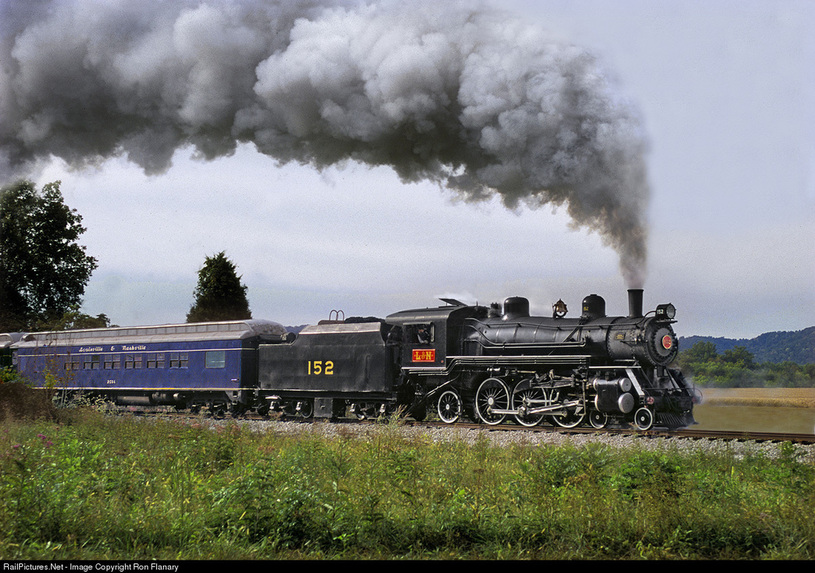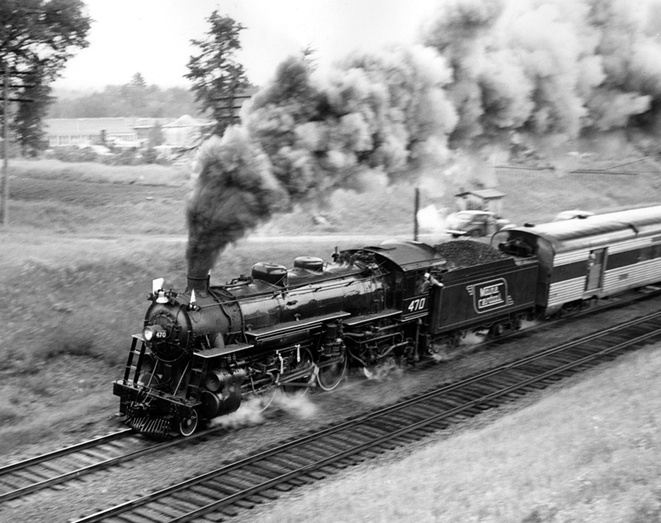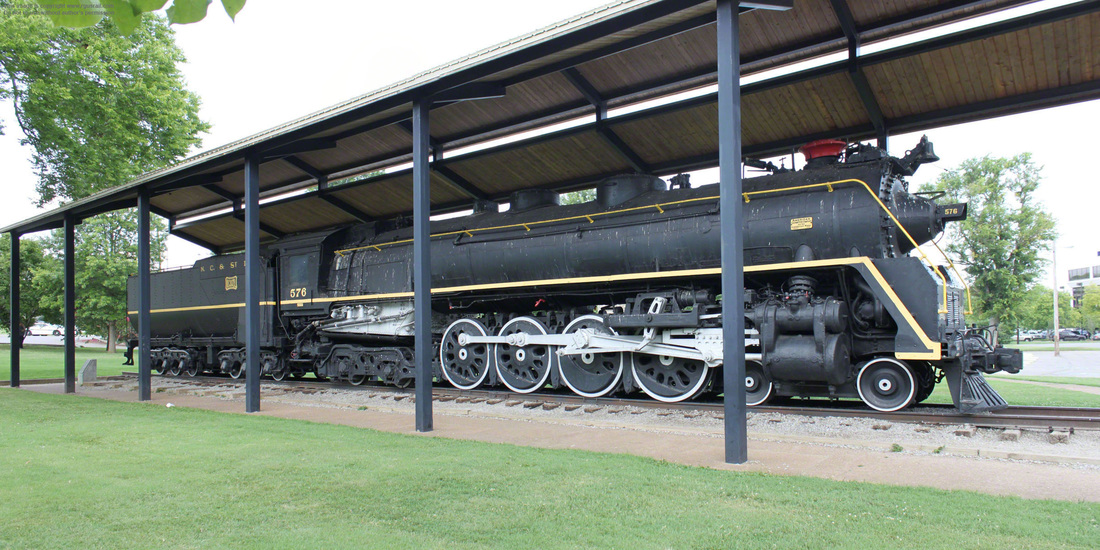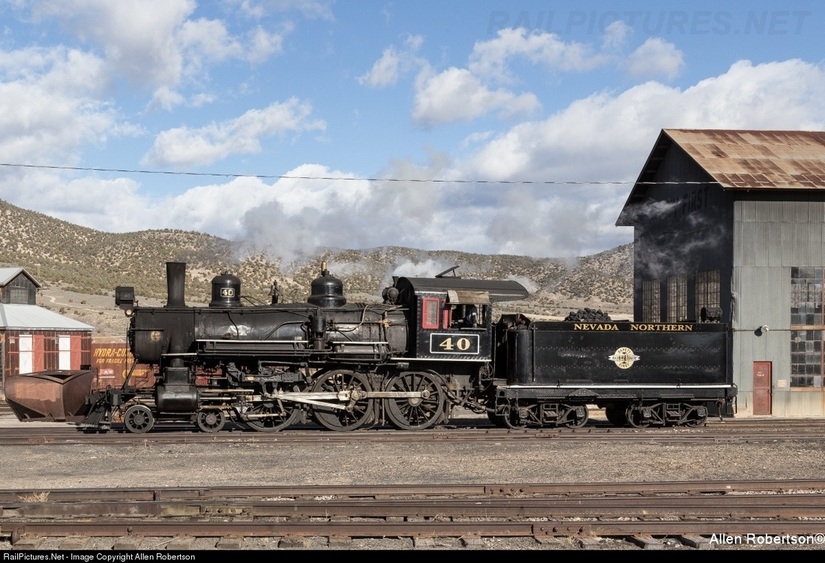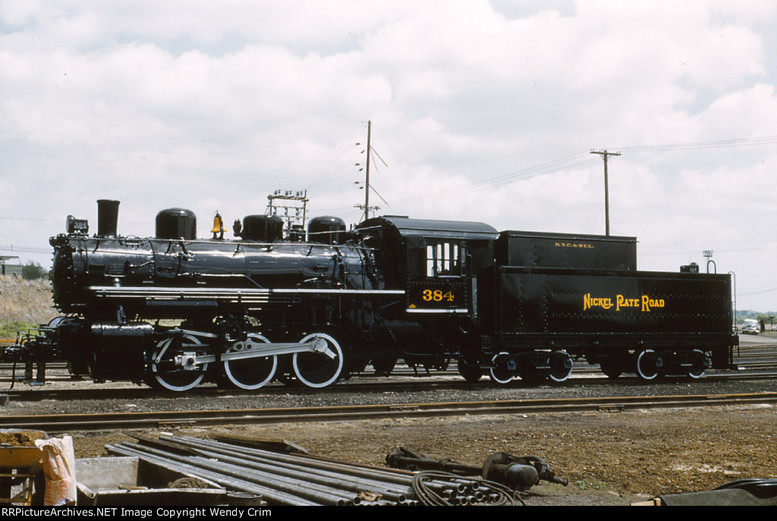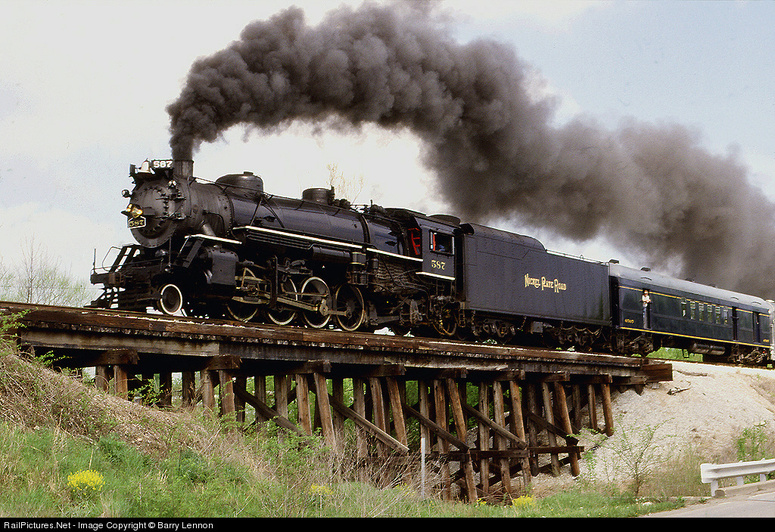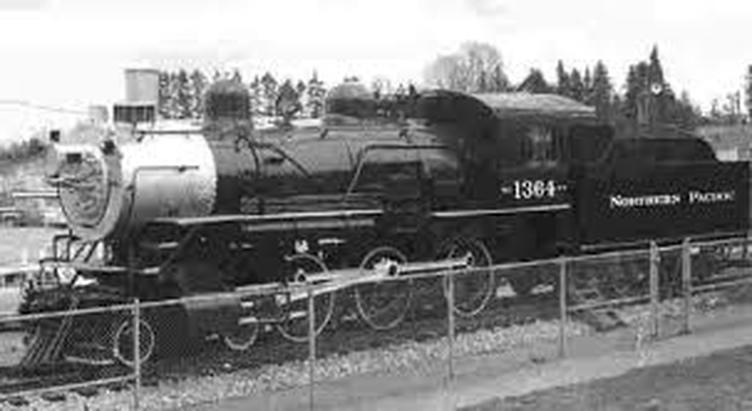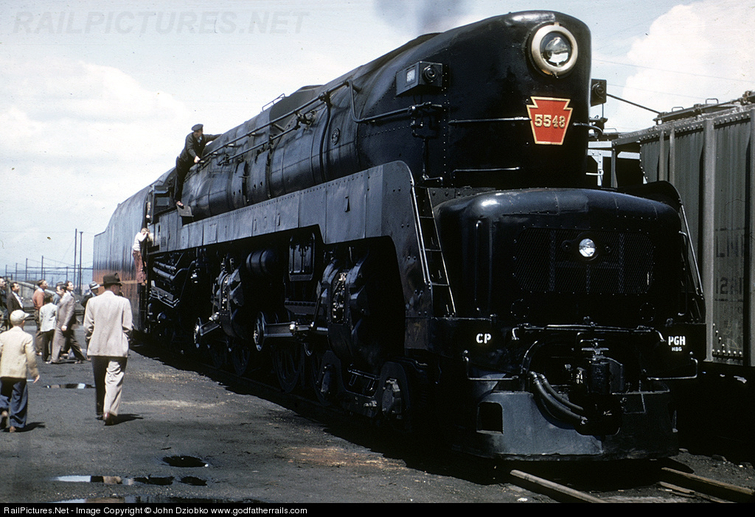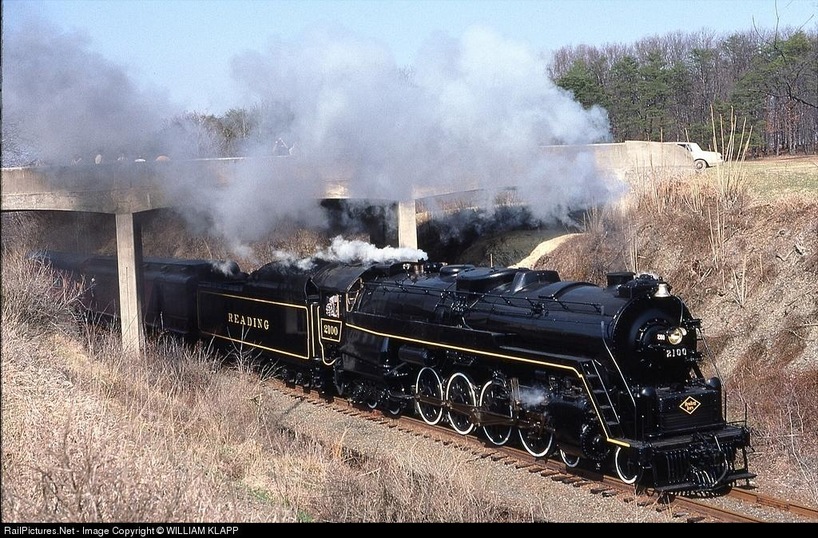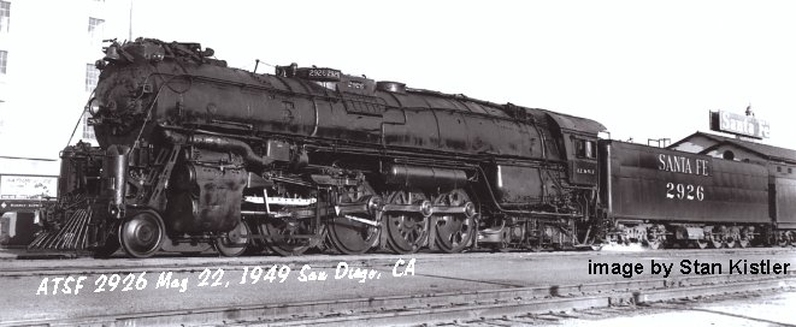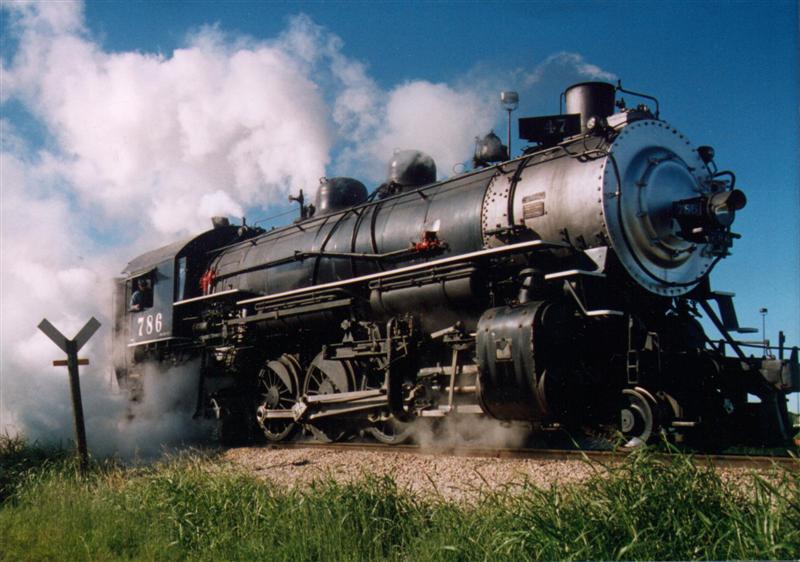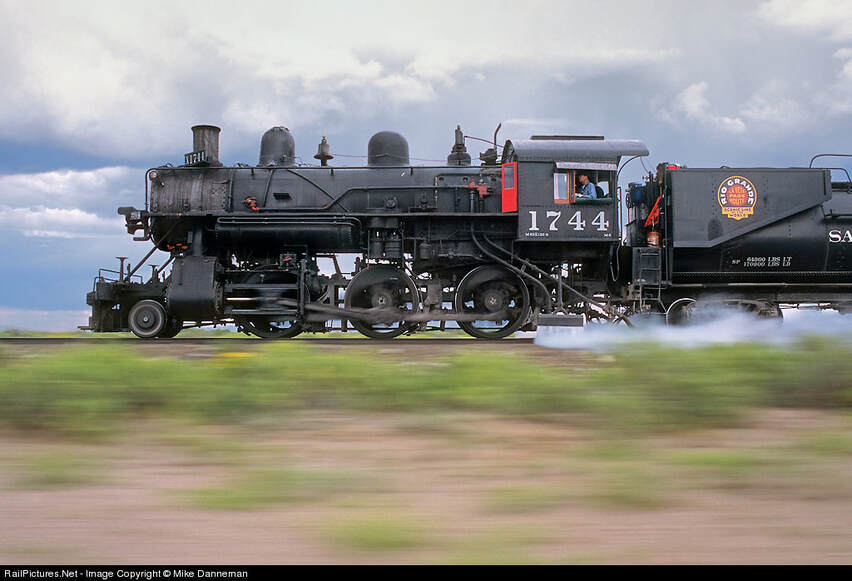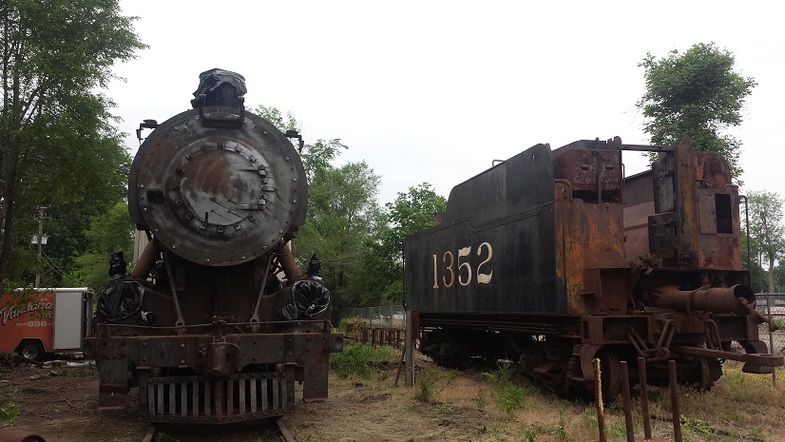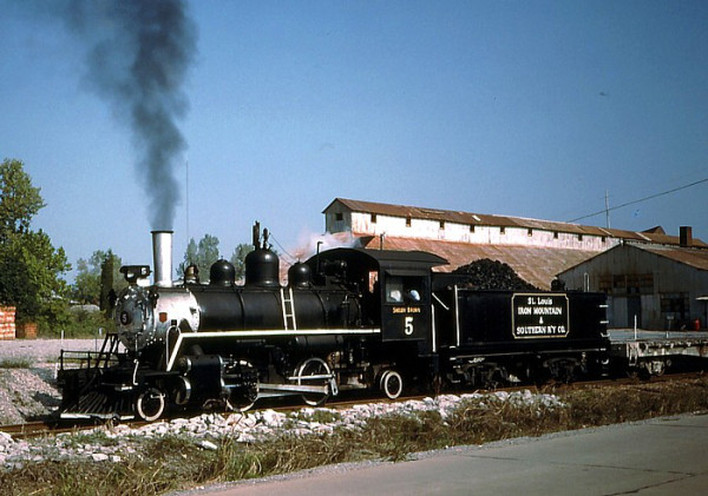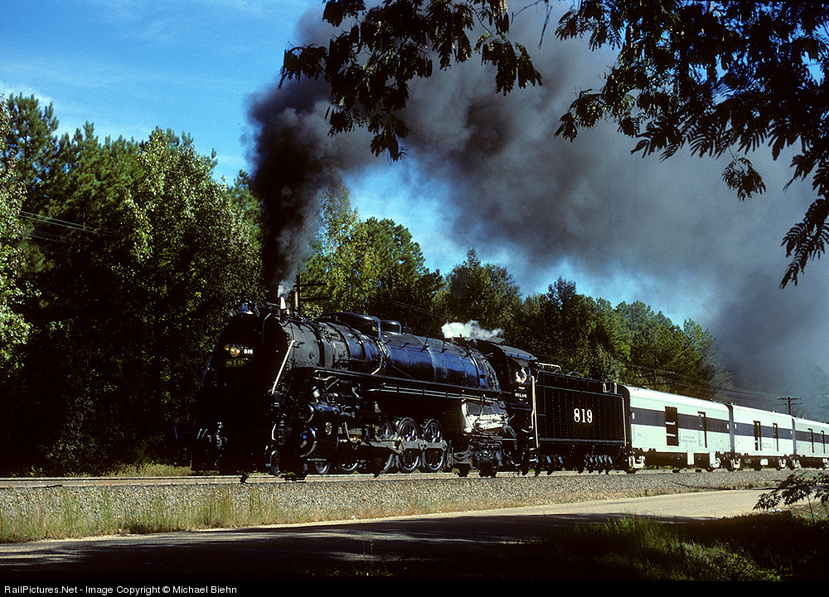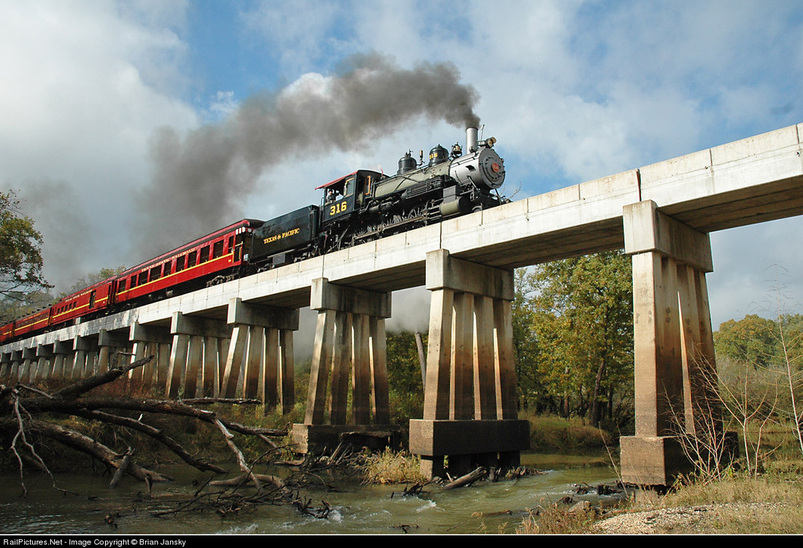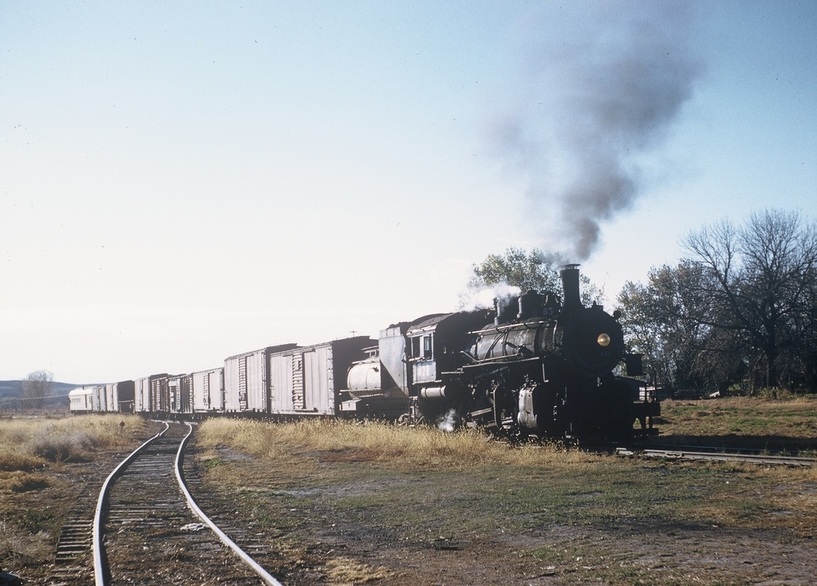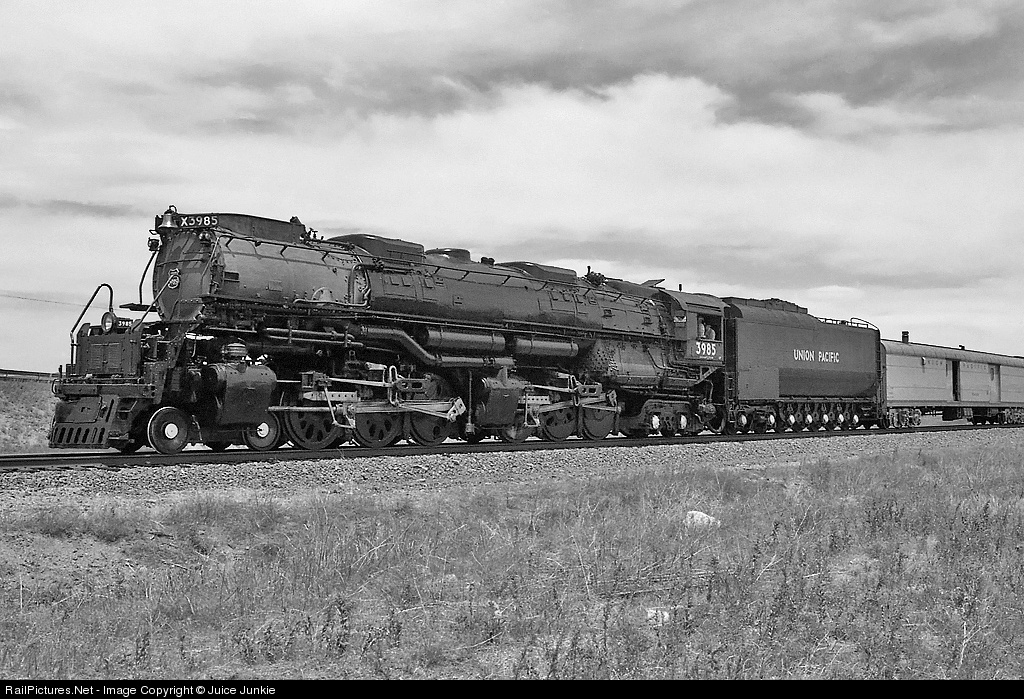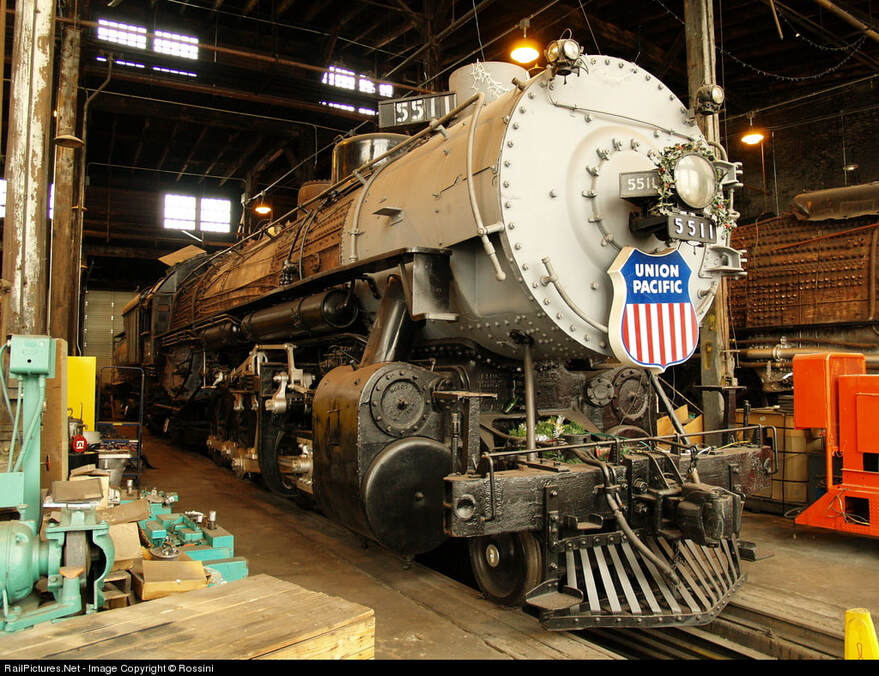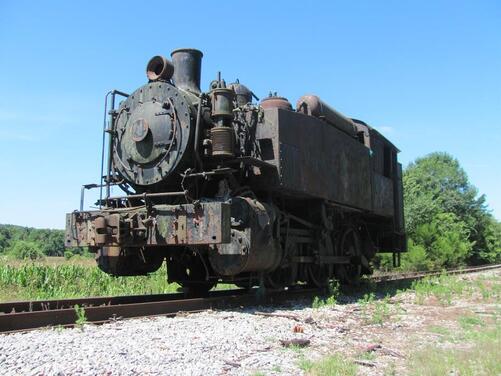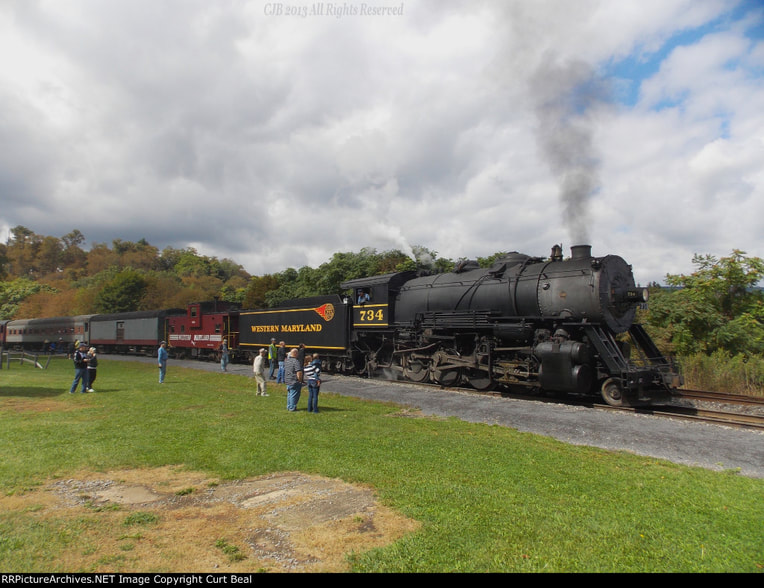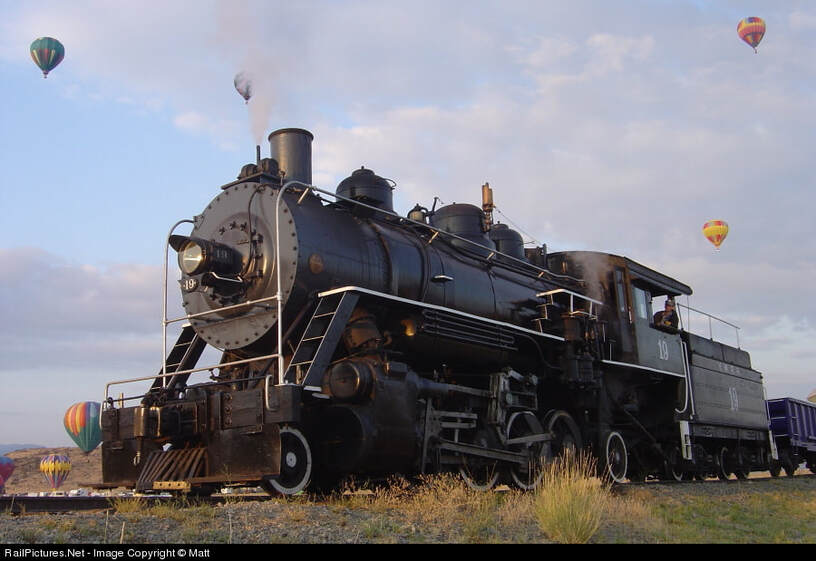Restoration Projects
There are many groups endeavoring to restore steam locomotives across the US. Those listed below are but a sampling. As with the operational page, this section will also be updated to show projects that are completed or started, when I have knowledge of them. The links provided will be one link to see the engine and where to go to help support the engine. The order of the locomotives listed below does not in any way denote bias towards those groups. The locomotives were added as they came to mind and are organized alphabetically. If you are interested in the sources used, please see the sources page under the "More" tab.
Alaska Railroad #557
Picture credit - Pat Durand
Type: 2-8-0 Consolidation
Stats:
Year Built - 1944
Built By - Baldwin Locomotive Works
Fuel - Oil (Originally Coal)
Boiler Pressure - 225lbs
Driving Wheel Diameter - 57in
Tractive Effort - 31,500lbs
Top Speed - 40mph
Road History - Alaska Railroad
History:
This War Department Consolidation design provided a perfect motive power for wartime motive power shortages in Africa and Europe. Built compactly to meet European loading gauges and with a flexible suspension to compensate for war-torn European railroads, they were powerful and included many modern features, including superheat. They were designed with wartime material and labor shortages in mind and many parts were fabricated or flame cut (including the frames on some locomotives). The three major locomotive builders each built about equal numbers of the 2,120 locomotives of this design for the U.S. War Department. All but about 15 were sent overseas to work on the fronts. A few were retained in the U.S. for troop training. Six were modified for U.S. use by Baldwin with the addition of electric lighting, power reverse, knuckle couplers, bell, and power reverse and were purchased under Army contracts by Federally owned Alaska Railroad. After the war, the Railroad obtained another six as war surplus and modified to U.S. specifications. In the early 1950s, the rest of the steam fleet was retired. 557 was converted to an oil burner and retained for standby service and special occasions. In 1964, 557 was surplus and sold as scrap. Thankfully, the locomotive was purchased from the scrap dealer and spent many years residing in a museum in Moses Lake, Washington. In 2011, studies found that the locomotive was a restoration candidate, the locomotive was returned to Alaska, and work began in earnest.
Summary:
To date, the engine has been completely torn apart and rebuilt as needed. As the parts are finished, she's starting to become complete once again. The new firebox has been installed and the tender is largely complete. Although still a few years out, the engine is certainly well on its way to running again, with steam tests projected to take place in 2019!
***Thank you to Mr. Dick Morris, Treasurer of Project 557, for your help!
Short Story:
In 1962, there was a massive flood in Nenana, Alaska. The 557 was used to shuttle trains through the high waters, with the water sometimes reaching the base of the firebox! Diesels waited on the high ground on either side as the 557 worked through the flood waters.
Links:
Project 557 History
YouTube (Restoration Tour)
Type: 2-8-0 Consolidation
Stats:
Year Built - 1944
Built By - Baldwin Locomotive Works
Fuel - Oil (Originally Coal)
Boiler Pressure - 225lbs
Driving Wheel Diameter - 57in
Tractive Effort - 31,500lbs
Top Speed - 40mph
Road History - Alaska Railroad
History:
This War Department Consolidation design provided a perfect motive power for wartime motive power shortages in Africa and Europe. Built compactly to meet European loading gauges and with a flexible suspension to compensate for war-torn European railroads, they were powerful and included many modern features, including superheat. They were designed with wartime material and labor shortages in mind and many parts were fabricated or flame cut (including the frames on some locomotives). The three major locomotive builders each built about equal numbers of the 2,120 locomotives of this design for the U.S. War Department. All but about 15 were sent overseas to work on the fronts. A few were retained in the U.S. for troop training. Six were modified for U.S. use by Baldwin with the addition of electric lighting, power reverse, knuckle couplers, bell, and power reverse and were purchased under Army contracts by Federally owned Alaska Railroad. After the war, the Railroad obtained another six as war surplus and modified to U.S. specifications. In the early 1950s, the rest of the steam fleet was retired. 557 was converted to an oil burner and retained for standby service and special occasions. In 1964, 557 was surplus and sold as scrap. Thankfully, the locomotive was purchased from the scrap dealer and spent many years residing in a museum in Moses Lake, Washington. In 2011, studies found that the locomotive was a restoration candidate, the locomotive was returned to Alaska, and work began in earnest.
Summary:
To date, the engine has been completely torn apart and rebuilt as needed. As the parts are finished, she's starting to become complete once again. The new firebox has been installed and the tender is largely complete. Although still a few years out, the engine is certainly well on its way to running again, with steam tests projected to take place in 2019!
***Thank you to Mr. Dick Morris, Treasurer of Project 557, for your help!
Short Story:
In 1962, there was a massive flood in Nenana, Alaska. The 557 was used to shuttle trains through the high waters, with the water sometimes reaching the base of the firebox! Diesels waited on the high ground on either side as the 557 worked through the flood waters.
Links:
Project 557 History
YouTube (Restoration Tour)
Arcade and Attica #18
Picture credit - Mitch Goldman
Type: 2-8-0 Consolidation
Stats:
Year Built - 1920
Built By - American Locomotive Works
Fuel - Coal
Boiler Pressure - 175lbs
Driving Wheel Diameter - 50in
Tractive Effort - 28,400lbs
Top Speed - 40mph
Road History - Boyne City, Arcade and Attica
History:
The Boyne City Railroad in Michigan ordered the #18 in 1920 to take care of freight service on the railroad. It was a small Consolidation for the time, but served the railroad well. In 1962, the Arcade and Attica bought the engine to revive the railroad, as it had fallen on hard times. Steam excursions started later that year, with #18 leading the way for the railroad. It stabilized the failing situation at the A&A, and still serves the railroad today.
Summary:
In a time of modernization, the Arcade and Attica turned to an almost forty year old steam locomotive to revive their operations. Since 1962, the engine has served on the railroad hauling passenger excursions. Occasionally, the engine is used for photo freight excursions and is known for the shiny copper paint scheme that runs along the boiler. However, the engine was recently sidelined for much needed boiler work; while no timeline exists, look for her to return as soon as funding allows!
Odd Fact:
The 18 was rebuilt to meet FRA specs, but sister engine #14, a 4-6-0 at the A&A, is stored on site awaiting both planning and funding for the future.
Links:
Arcade and Attica Railroad History
YouTube
Type: 2-8-0 Consolidation
Stats:
Year Built - 1920
Built By - American Locomotive Works
Fuel - Coal
Boiler Pressure - 175lbs
Driving Wheel Diameter - 50in
Tractive Effort - 28,400lbs
Top Speed - 40mph
Road History - Boyne City, Arcade and Attica
History:
The Boyne City Railroad in Michigan ordered the #18 in 1920 to take care of freight service on the railroad. It was a small Consolidation for the time, but served the railroad well. In 1962, the Arcade and Attica bought the engine to revive the railroad, as it had fallen on hard times. Steam excursions started later that year, with #18 leading the way for the railroad. It stabilized the failing situation at the A&A, and still serves the railroad today.
Summary:
In a time of modernization, the Arcade and Attica turned to an almost forty year old steam locomotive to revive their operations. Since 1962, the engine has served on the railroad hauling passenger excursions. Occasionally, the engine is used for photo freight excursions and is known for the shiny copper paint scheme that runs along the boiler. However, the engine was recently sidelined for much needed boiler work; while no timeline exists, look for her to return as soon as funding allows!
Odd Fact:
The 18 was rebuilt to meet FRA specs, but sister engine #14, a 4-6-0 at the A&A, is stored on site awaiting both planning and funding for the future.
Links:
Arcade and Attica Railroad History
YouTube
Boone and Scenic Valley Railroad #8419
Picture credit - wangruoyao
Type: 2-8-2
Stats:
Year Built - 1989
Built By - Datong Locomotive Works (China)
Fuel - Coal
Boiler Pressure - 200lbs
Driving Wheel Diameter - 54in.
Tractive Effort - 56,770lbs
Top Speed - 53mph
History - Boone & Scenic Valley Railroad
History:
As late as 1989, China was still building steam locmotives. One of the last engines built there, or anywhere in the world, was #8419. Built with the traditional Chinese styling, it arrived in the US for use at the Boone & Scenic Valley Railroad, where the engine has operated since being brought over.
Summary:
The 8419 was built for freight service, but has found a niche as a museum lcoomotive at the Boone and Scenic Valley. While it retains its Chinese styling, she's been in the US for far longer than she was ever in China. And she's got quite the following at the B&SVR, where she's currently undergoing her 1,472 service day inspection and rebuild.
Odd Fact:
The story goes that, once 8419 was out the door, the Datong Locomotive Works in China converted to diesel-electric locomotive production, thus making 8419 one of the last, if not the last, commercially built steam locomotive in the world (not counting the much more recent Kloke Locomotive Works' products).
Links:
Boone & Scenic Valley Railroad
YouTube
Type: 2-8-2
Stats:
Year Built - 1989
Built By - Datong Locomotive Works (China)
Fuel - Coal
Boiler Pressure - 200lbs
Driving Wheel Diameter - 54in.
Tractive Effort - 56,770lbs
Top Speed - 53mph
History - Boone & Scenic Valley Railroad
History:
As late as 1989, China was still building steam locmotives. One of the last engines built there, or anywhere in the world, was #8419. Built with the traditional Chinese styling, it arrived in the US for use at the Boone & Scenic Valley Railroad, where the engine has operated since being brought over.
Summary:
The 8419 was built for freight service, but has found a niche as a museum lcoomotive at the Boone and Scenic Valley. While it retains its Chinese styling, she's been in the US for far longer than she was ever in China. And she's got quite the following at the B&SVR, where she's currently undergoing her 1,472 service day inspection and rebuild.
Odd Fact:
The story goes that, once 8419 was out the door, the Datong Locomotive Works in China converted to diesel-electric locomotive production, thus making 8419 one of the last, if not the last, commercially built steam locomotive in the world (not counting the much more recent Kloke Locomotive Works' products).
Links:
Boone & Scenic Valley Railroad
YouTube
Boston and Maine #3713
Picture credit - http://project3713.com/wp/?page_id=304
Type: 4-6-2 Pacific
Stats:
Year Built - 1934
Built By - Lima Locomotive Works
Fuel - Coal
Boiler Pressure - 260lbs
Driving Wheel Diameter - 80in
Tractive Effort - 40,900lbs
Top Speed - 80mph
Road History - Boston and Maine Railroad
History:
The Boston and Maine Railroad had a thing for Pacific type locomotives. They originally ordered more than 90 of these from the American Locomotive Company in the 1910's and 1920's. In 1934, they found that they needed a more powerful type Pacific, and turned to the Lima Locomotive Works for such an engine. The result, in two very similar classes, were the B&M's 3710-3719 Pacific locomotives. They handled the passenger traffic on the road, almost exclusively at that, until dieselization. Of the 10 Lima and 92 ALCO Pacific engines built for the B&M, 3713 is the only survivor.
Summary:
Originally, the 3713 was acquired by F. Nelson Blount, the founder of Steamtown. For many years, it was a display locomotive. Steamtown had other operational engines, and 3713 was in good cosmetic condition. Despite that, though, fundraising for the operational restoration of 3713 began in 1995. The restoration work, however, has been an ongoing project, as many steam locomotive restorations are. Her boiler work is nearly done, and running gear work progresses as well. Since the completion of Baldwin 26, work has begun in earnest on the 3713 once again. It will be a few years, but she will be back!
Odd Fact:
The 3713 received the nickname, "The Constitution" during her time at the B&M after the road held a naming contest for the engines. The contest was centered towards schoolchildren, and has since led to the engine being known as, "America's Locomotive."
Links:
Project 3713
No YouTube videos exist for this locomotive.
Type: 4-6-2 Pacific
Stats:
Year Built - 1934
Built By - Lima Locomotive Works
Fuel - Coal
Boiler Pressure - 260lbs
Driving Wheel Diameter - 80in
Tractive Effort - 40,900lbs
Top Speed - 80mph
Road History - Boston and Maine Railroad
History:
The Boston and Maine Railroad had a thing for Pacific type locomotives. They originally ordered more than 90 of these from the American Locomotive Company in the 1910's and 1920's. In 1934, they found that they needed a more powerful type Pacific, and turned to the Lima Locomotive Works for such an engine. The result, in two very similar classes, were the B&M's 3710-3719 Pacific locomotives. They handled the passenger traffic on the road, almost exclusively at that, until dieselization. Of the 10 Lima and 92 ALCO Pacific engines built for the B&M, 3713 is the only survivor.
Summary:
Originally, the 3713 was acquired by F. Nelson Blount, the founder of Steamtown. For many years, it was a display locomotive. Steamtown had other operational engines, and 3713 was in good cosmetic condition. Despite that, though, fundraising for the operational restoration of 3713 began in 1995. The restoration work, however, has been an ongoing project, as many steam locomotive restorations are. Her boiler work is nearly done, and running gear work progresses as well. Since the completion of Baldwin 26, work has begun in earnest on the 3713 once again. It will be a few years, but she will be back!
Odd Fact:
The 3713 received the nickname, "The Constitution" during her time at the B&M after the road held a naming contest for the engines. The contest was centered towards schoolchildren, and has since led to the engine being known as, "America's Locomotive."
Links:
Project 3713
No YouTube videos exist for this locomotive.
Buffalo Creek and Gauley #4
Picture credit - Tom Sink
Type: 2-8-0 Consolidation
Stats:
Year Built - 1926
Built By - Baldwin Locomotive Works
Fuel - Coal
Boiler Pressure - 180lbs
Driving Wheel Diameter - 51in
Tractive Effort - 41,500lbs
Top Speed - 45mph
Road History - Buffalo Creek and Gauley, Southwest Virginia, Cass Scenic Railroad
History:
Consolidations were built for a vast number of different tasks, making their design variances quite interesting. This engine was built for slower speed service, and was a standard freight hauler of the mid 1920's. For this time period, however, the driving wheels are a little small, meaning that tractive effort was more of a concern for the BC&G when it came to locomotive designs. Number 4 was retired in 1965, before going to a few tourist operations. After those operations failed, she was shipped to the North Carolina Transportation Museum, where she ran tours up until 2001. Necessary repairs on the engine were started, but not completed during her time at the museum.
Summary:
The Durbin and Greenbriar Railroad took over operations at the Cass Scenic Railroad in late 2014, and since then have begun work on a variety of different projects. One of those projects was the acquisition of #4, paying the NCTM $150,000 for the engine. As restoration had already begun on the locomotive, she should be back on the rails quickly. But, the route the D&G wants to use her for will take far longer to repair. In time however, the engine will return to service, pulling trains on the reconstructed line from Cass to Durbin.
Odd Fact:
The #4 is known as, "Slobberface", due to the large amounts of water she sweats during operation!
Links:
Durbin and Greenbrier Railroad
YouTube (Engine painted as Southern 604)
Type: 2-8-0 Consolidation
Stats:
Year Built - 1926
Built By - Baldwin Locomotive Works
Fuel - Coal
Boiler Pressure - 180lbs
Driving Wheel Diameter - 51in
Tractive Effort - 41,500lbs
Top Speed - 45mph
Road History - Buffalo Creek and Gauley, Southwest Virginia, Cass Scenic Railroad
History:
Consolidations were built for a vast number of different tasks, making their design variances quite interesting. This engine was built for slower speed service, and was a standard freight hauler of the mid 1920's. For this time period, however, the driving wheels are a little small, meaning that tractive effort was more of a concern for the BC&G when it came to locomotive designs. Number 4 was retired in 1965, before going to a few tourist operations. After those operations failed, she was shipped to the North Carolina Transportation Museum, where she ran tours up until 2001. Necessary repairs on the engine were started, but not completed during her time at the museum.
Summary:
The Durbin and Greenbriar Railroad took over operations at the Cass Scenic Railroad in late 2014, and since then have begun work on a variety of different projects. One of those projects was the acquisition of #4, paying the NCTM $150,000 for the engine. As restoration had already begun on the locomotive, she should be back on the rails quickly. But, the route the D&G wants to use her for will take far longer to repair. In time however, the engine will return to service, pulling trains on the reconstructed line from Cass to Durbin.
Odd Fact:
The #4 is known as, "Slobberface", due to the large amounts of water she sweats during operation!
Links:
Durbin and Greenbrier Railroad
YouTube (Engine painted as Southern 604)
Cass Scenic Railroad #2
Picture credit - Walter S.
Type: 3 Truck Shay
Stats:
Year Built - 1928
Built By - Lima Locomotive Works
Fuel - Coal
Boiler Pressure - 200lbs
Driving Wheel Diameter - 36in
Tractive Effort - 38,200lbs
Top Speed - 25mph
Road History - Mayo Lumber Company, Lake Logging Company, Western Forest Industries, Cass Scenic Railroad
History:
Cass Scenic Railroad's Shay 2 is an example of a West Coast Shay. The design was much more user friendly in many cases when compared to other shay locomotives. She has a larger firebox, super heaters and the motor is designed to attach only to the frame, not to the boiler. Most of her time was spent running in Canada, where she served primarily in British Columbia. She is the only West Coast Shay currently operating on the East Coast.
Summary:
Shay 2 ran for many years on the Cass Scenic. She was popular on the railroad, and did a good job running there. Currently, she is out of service receiving needed repairs as part of her 1,472 inspection and rebuild, including boiler work and running gear maintenance. As soon as these repairs are completed, she will return to service alongside her sisters at the CSRR.
Odd Fact:
Shay 2 is the only known shay to burn 3 fuel types; lumber, oil and then coal.
Links:
Cass Scenic Railroad Shay 2
YouTube
Type: 3 Truck Shay
Stats:
Year Built - 1928
Built By - Lima Locomotive Works
Fuel - Coal
Boiler Pressure - 200lbs
Driving Wheel Diameter - 36in
Tractive Effort - 38,200lbs
Top Speed - 25mph
Road History - Mayo Lumber Company, Lake Logging Company, Western Forest Industries, Cass Scenic Railroad
History:
Cass Scenic Railroad's Shay 2 is an example of a West Coast Shay. The design was much more user friendly in many cases when compared to other shay locomotives. She has a larger firebox, super heaters and the motor is designed to attach only to the frame, not to the boiler. Most of her time was spent running in Canada, where she served primarily in British Columbia. She is the only West Coast Shay currently operating on the East Coast.
Summary:
Shay 2 ran for many years on the Cass Scenic. She was popular on the railroad, and did a good job running there. Currently, she is out of service receiving needed repairs as part of her 1,472 inspection and rebuild, including boiler work and running gear maintenance. As soon as these repairs are completed, she will return to service alongside her sisters at the CSRR.
Odd Fact:
Shay 2 is the only known shay to burn 3 fuel types; lumber, oil and then coal.
Links:
Cass Scenic Railroad Shay 2
YouTube
Chesapeake and Ohio #2716
Picture credit - Bruce Wilson
Type: 2-8-4 Kanawha
Stats:
Year Built - 1943
Built By - American Locomotive Company
Fuel - Coal
Boiler Pressure - 245lbs
Driving Wheel Diameter - 69in
Tractive Effort - 69,350lbs
Top Speed - 90mph
Road History - Chesapeake and Ohio, Southern Railway (Steam Program only)
History:
The Chesapeake and Ohio Railroad was one of the premier railroads in the Eastern United States. Their steam locomotive fleet was quite varied and impressive in its heyday, and included many examples of the Berkshire type steam locomotive. On the C&O, however, Berkshires were called Kanawhas due to the Kanawha River running parallel to its mainline. They handled much of the fast freight on the line stemming from World War II, and survived well past the conflict to continue in this role. Ninety such engines operated on the C&O, with twelve examples surviving into the preservation era.
Summary:
The 2716 has had a tumultuous retirement. She was restored as part of the original Southern Railway Steam Program, but was not run often during the duration of the program. She was serviceable by all accounts, but engines like Southern 4501, Norfolk and Western 611 and Norfolk and Western 1218 were more popular counterparts and, with the exception of the 4501, could pull heavier trains. In 1994, the Fort Wayne Railroad Historical Society leased the engine, restored it to operation and operated it a handful of times in 1996 due to their Berkshire, NKP 765, needing a thorough running gear overhaul. But, late in 1996, the FRA changed the rules regarding steam locomotive operation, and the group decided to concentrate on 765. They returned 2716 to the Kentucky Railway Museum that year. She sat for almost twenty years when, on 2-7-16 (yes, that was on purpose), it was announced that the Kentucky Steam Heritage Corp had signed a long term lease to the engine and was preparing to move it for an operational restoration. They estimate the restoration cost of the engine to be between 800k and 1.3 million dollars, and are fundraising with those goals in mind. If the funding goes as planned, they hope to have the engine running by 2020.
Odd Fact:
Ironically, when 2716 originally entered the Southern Steam Program, she suffered a mechanical failure that kept her out of service. In that time, the Southern leased NKP 765 from the FWRHS, and they operated 765 while 2716 was repaired. Later, when the 765 was in need of repairs, the FWRHS selected 2716 to serve as its sub, albeit briefly.
Links:
Kentucky Steam Heritage Corporation
YouTube
Type: 2-8-4 Kanawha
Stats:
Year Built - 1943
Built By - American Locomotive Company
Fuel - Coal
Boiler Pressure - 245lbs
Driving Wheel Diameter - 69in
Tractive Effort - 69,350lbs
Top Speed - 90mph
Road History - Chesapeake and Ohio, Southern Railway (Steam Program only)
History:
The Chesapeake and Ohio Railroad was one of the premier railroads in the Eastern United States. Their steam locomotive fleet was quite varied and impressive in its heyday, and included many examples of the Berkshire type steam locomotive. On the C&O, however, Berkshires were called Kanawhas due to the Kanawha River running parallel to its mainline. They handled much of the fast freight on the line stemming from World War II, and survived well past the conflict to continue in this role. Ninety such engines operated on the C&O, with twelve examples surviving into the preservation era.
Summary:
The 2716 has had a tumultuous retirement. She was restored as part of the original Southern Railway Steam Program, but was not run often during the duration of the program. She was serviceable by all accounts, but engines like Southern 4501, Norfolk and Western 611 and Norfolk and Western 1218 were more popular counterparts and, with the exception of the 4501, could pull heavier trains. In 1994, the Fort Wayne Railroad Historical Society leased the engine, restored it to operation and operated it a handful of times in 1996 due to their Berkshire, NKP 765, needing a thorough running gear overhaul. But, late in 1996, the FRA changed the rules regarding steam locomotive operation, and the group decided to concentrate on 765. They returned 2716 to the Kentucky Railway Museum that year. She sat for almost twenty years when, on 2-7-16 (yes, that was on purpose), it was announced that the Kentucky Steam Heritage Corp had signed a long term lease to the engine and was preparing to move it for an operational restoration. They estimate the restoration cost of the engine to be between 800k and 1.3 million dollars, and are fundraising with those goals in mind. If the funding goes as planned, they hope to have the engine running by 2020.
Odd Fact:
Ironically, when 2716 originally entered the Southern Steam Program, she suffered a mechanical failure that kept her out of service. In that time, the Southern leased NKP 765 from the FWRHS, and they operated 765 while 2716 was repaired. Later, when the 765 was in need of repairs, the FWRHS selected 2716 to serve as its sub, albeit briefly.
Links:
Kentucky Steam Heritage Corporation
YouTube
Chicago & North Western Railroad #1385
Picture credit - Bob Lyndall
Type: 4-6-0 "Ten Wheeler"
Stats:
Year Built - 1907
Built By - American Locomotive Company
Fuel - Coal
Boiler Pressure - 200lbs
Driving Wheel Diameter - 63in
Tractive Effort - 30,940lbs
Top Speed - 75MPH
Road History - Chicago & North Western
History:
The class R-1 "Ten Wheeler's" of the Chicago and North Western were a popular breed, with more than 300 being built and used by the railroad for passenger and freight service. Every engine was unique; some were Baldwin, some were ALCO. Different types of valve gear were also used on the different engines, making for a unique class of railroad engine. While not the strongest locomotives on the C&NW system, they were commonplace due to their sheer numbers. In fact, much of the C&NW system had to be rebuilt to handle the engines when they arrived in the early 1900's. Not many C&NW steam locomotives survived; 1385 was the only one operational until it was taken out of service in 1998.
Summary:
The 1385 is a popular engine in the Midwest, having run over mainline territory in the 1980's for a heritage tour. She's also a unique engine, her Stephenson valve gear located underneath the boiler instead of outside the driving wheels. She was the first steam engine under steam at the Mid-Continent Railway Museum, where she ran from roughly 1963 to 1998. Since 1998, the 1385 has been under restoration at the Mid-Continent. Limited funds slowed the project, but it has recently seen renewed vigor.
Odd Fact:
The Mid-Continent Railway Museum bought the 1385 from the C&NW for $2,600!
Links:
Mid-Continent Railway Museum Steam Status page
YouTube
Type: 4-6-0 "Ten Wheeler"
Stats:
Year Built - 1907
Built By - American Locomotive Company
Fuel - Coal
Boiler Pressure - 200lbs
Driving Wheel Diameter - 63in
Tractive Effort - 30,940lbs
Top Speed - 75MPH
Road History - Chicago & North Western
History:
The class R-1 "Ten Wheeler's" of the Chicago and North Western were a popular breed, with more than 300 being built and used by the railroad for passenger and freight service. Every engine was unique; some were Baldwin, some were ALCO. Different types of valve gear were also used on the different engines, making for a unique class of railroad engine. While not the strongest locomotives on the C&NW system, they were commonplace due to their sheer numbers. In fact, much of the C&NW system had to be rebuilt to handle the engines when they arrived in the early 1900's. Not many C&NW steam locomotives survived; 1385 was the only one operational until it was taken out of service in 1998.
Summary:
The 1385 is a popular engine in the Midwest, having run over mainline territory in the 1980's for a heritage tour. She's also a unique engine, her Stephenson valve gear located underneath the boiler instead of outside the driving wheels. She was the first steam engine under steam at the Mid-Continent Railway Museum, where she ran from roughly 1963 to 1998. Since 1998, the 1385 has been under restoration at the Mid-Continent. Limited funds slowed the project, but it has recently seen renewed vigor.
Odd Fact:
The Mid-Continent Railway Museum bought the 1385 from the C&NW for $2,600!
Links:
Mid-Continent Railway Museum Steam Status page
YouTube
Cowlitz, Chehalis & Cascade railway #15
Picture credit - http://www.rgusrail.com/waccrm.html
Type - 2-8-2 Mikado
Stats:
Year Built - 1916
Built By - Baldwin Locomotive Works
Fuel - Fuel Oil
Boiler Pressure - 170lbs
Driving Wheel Diameter - 48in
Tractive Effort - 35,425lbs
Top Speed - 40mph
Road History - Clear Lake Lumber Co., Cowlitz, Chehalis & Cascade Railway
History:
Built in 1916, the 15 resembles a typical logging Mikado type locomotive. It has small drivers, of which the center drivers are flangeless, allowing the engine to take tight turns. The engine was originally ordered by the Clear Lake Lumber Co, but when that company went bankrupt in 1926 the engine was repossessed by Baldwin. It was sold to the CC&C RR in 1928.
Summary:
The 15 is one of the few normally operated steam locomotives in the state of Washington. The engine now runs for a tourist railroad/museum, and is their star. She works hauling fan trips, murder-mysteries and diner trains, only to name a few special runs. Being one of the few engines normally operating in WA, she's well traveled and popular. However, she's currently out of service for needed boiler repairs and a 1,472 day inspection.
Odd Fact:
Engines didn't always survive a bankruptcy; luckily for the 15, another logging operation was in need of motive power.
Links:
Chehalis-Centralia Railroad & Museum
YouTube
Type - 2-8-2 Mikado
Stats:
Year Built - 1916
Built By - Baldwin Locomotive Works
Fuel - Fuel Oil
Boiler Pressure - 170lbs
Driving Wheel Diameter - 48in
Tractive Effort - 35,425lbs
Top Speed - 40mph
Road History - Clear Lake Lumber Co., Cowlitz, Chehalis & Cascade Railway
History:
Built in 1916, the 15 resembles a typical logging Mikado type locomotive. It has small drivers, of which the center drivers are flangeless, allowing the engine to take tight turns. The engine was originally ordered by the Clear Lake Lumber Co, but when that company went bankrupt in 1926 the engine was repossessed by Baldwin. It was sold to the CC&C RR in 1928.
Summary:
The 15 is one of the few normally operated steam locomotives in the state of Washington. The engine now runs for a tourist railroad/museum, and is their star. She works hauling fan trips, murder-mysteries and diner trains, only to name a few special runs. Being one of the few engines normally operating in WA, she's well traveled and popular. However, she's currently out of service for needed boiler repairs and a 1,472 day inspection.
Odd Fact:
Engines didn't always survive a bankruptcy; luckily for the 15, another logging operation was in need of motive power.
Links:
Chehalis-Centralia Railroad & Museum
YouTube
Denver And Rio Grande Western #223
Picture credit - C. W. Lahickey
Type: 3ft gauge 2-8-0 Consolidation
Stats:
Year Built - 1881
Built By - Grant Locomotive Works
Fuel - Coal
Boiler Pressure - 160lbs
Driving Wheel Diameter - 36in
Tractive Effort - 16,540lbs
Top Speed - 30mph
Road History - Denver and Rio Grande Western
History:
The Denver and Rio Grande Western Railroad is perhaps the best known narrow gauge railroad in the United States. Many of its engines still operate, although those engines are later examples of what the railroad needed in terms of motive power. A few examples of its old motive power exist, however. These engines were light but sturdy, and were powerful for their time. The 223 is one such engine. It served the Rio Grande from 1881 to 1941 in part because its lighter weight allowed it to traverse the old trestle bridges on the line. Salt Lake City became the 223's home after retirement, until the Golden Spike chapter of the Railway and Locomotive Historical Society acquired and began rebuilding the engine in 1991.
Summary:
Large power was the name of the game in 1941. As such, smaller power was relegated to lighter service and generally received only spotty repairs. Such repairs mean lengthy restorations. Almost everything on the 223 has been taken off to receive much needed repairs. As such, the Golden Spike chapter continues to work on the engine and have accomplished much in its total rebuild. They hope to have the locomotive running by 2019, in time for the 150th anniversary of the completion of the Transcontinental Railroad.
Odd Fact:
Fires inside the firebox are good. Fires outside, however, can be bad news for steam engines. Despite that, 223 was involved in and survived no less than 3 fires!
Links:
Golden Spike Chapter of the Railway and Locomotive Historical Society
History of the 223
YouTube
Type: 3ft gauge 2-8-0 Consolidation
Stats:
Year Built - 1881
Built By - Grant Locomotive Works
Fuel - Coal
Boiler Pressure - 160lbs
Driving Wheel Diameter - 36in
Tractive Effort - 16,540lbs
Top Speed - 30mph
Road History - Denver and Rio Grande Western
History:
The Denver and Rio Grande Western Railroad is perhaps the best known narrow gauge railroad in the United States. Many of its engines still operate, although those engines are later examples of what the railroad needed in terms of motive power. A few examples of its old motive power exist, however. These engines were light but sturdy, and were powerful for their time. The 223 is one such engine. It served the Rio Grande from 1881 to 1941 in part because its lighter weight allowed it to traverse the old trestle bridges on the line. Salt Lake City became the 223's home after retirement, until the Golden Spike chapter of the Railway and Locomotive Historical Society acquired and began rebuilding the engine in 1991.
Summary:
Large power was the name of the game in 1941. As such, smaller power was relegated to lighter service and generally received only spotty repairs. Such repairs mean lengthy restorations. Almost everything on the 223 has been taken off to receive much needed repairs. As such, the Golden Spike chapter continues to work on the engine and have accomplished much in its total rebuild. They hope to have the locomotive running by 2019, in time for the 150th anniversary of the completion of the Transcontinental Railroad.
Odd Fact:
Fires inside the firebox are good. Fires outside, however, can be bad news for steam engines. Despite that, 223 was involved in and survived no less than 3 fires!
Links:
Golden Spike Chapter of the Railway and Locomotive Historical Society
History of the 223
YouTube
Denver and Rio Grande Western #493
Picture credit - Kevin Madore
Type: 36in Gauge 2-8-2
Stats:
Year Built - 1928
Built By - D&RGW Burnham Shops
Fuel - Coal
Boiler Pressure - 200lbs
Driving Wheel Diameter - 44in
Tractive Effort - 37,100lbs
Top Speed - 40mph
Road History - Denver and Rio Grande Western, Durango and Silverton
History:
D&S 493 has had a unique history. Originally a Baldwin Locomotive Works product, it started life as a standard gauge Consolidation on the Denver and Rio Grande Western before being converted to a narrow gauge Mikado in 1928. While these conversions did occur, they were quite rare. She served the railroad honorably until her retirement and subsequent acquisition by the Durango and Silverton.
Summary:
The 493 is a large engine for the Durango and Silverton. As such, the railroad museum associated withe the D&S operation agreed to donate 493 to the Colorado Railroad Museum, who will lease the engine for 10 years to return it to service and operate it on their property. The lease agreement, however, is not dead set on that 10 year limit. It could be extended. Either way, the engine will return to the D&S as an operational steam locomotive whenever the lease is ended!
Odd Fact:
Narrow gauge engines, for the most part, were great haulers, but they were never very fast!
Links:
Durango and Silverton
YouTube
Type: 36in Gauge 2-8-2
Stats:
Year Built - 1928
Built By - D&RGW Burnham Shops
Fuel - Coal
Boiler Pressure - 200lbs
Driving Wheel Diameter - 44in
Tractive Effort - 37,100lbs
Top Speed - 40mph
Road History - Denver and Rio Grande Western, Durango and Silverton
History:
D&S 493 has had a unique history. Originally a Baldwin Locomotive Works product, it started life as a standard gauge Consolidation on the Denver and Rio Grande Western before being converted to a narrow gauge Mikado in 1928. While these conversions did occur, they were quite rare. She served the railroad honorably until her retirement and subsequent acquisition by the Durango and Silverton.
Summary:
The 493 is a large engine for the Durango and Silverton. As such, the railroad museum associated withe the D&S operation agreed to donate 493 to the Colorado Railroad Museum, who will lease the engine for 10 years to return it to service and operate it on their property. The lease agreement, however, is not dead set on that 10 year limit. It could be extended. Either way, the engine will return to the D&S as an operational steam locomotive whenever the lease is ended!
Odd Fact:
Narrow gauge engines, for the most part, were great haulers, but they were never very fast!
Links:
Durango and Silverton
YouTube
Everett Railroad Company #38
Picture credit - http://www.everettrailroad.com/excursions/equipment/38.aspx
Type: 2-8-0 Consolidation
Stats:
Year Built - 1927
Built By - Baldwin Locomotive Works
Fuel - Coal
Boiler Pressure - 180lbs
Driving Wheel Diameter - 51in
Tractive Effort - 36,300lbs
Top Speed - 50mph
Road History - Huntingdon & Broad Top Mountain Railroad & Coal Company, Livonia, Avon & Lakeville Railroad, Gettysburg (PA) Railroad, Knox & Kane Railroad
History:
The 2-8-0 was always a popular choice for a steam locomotive. When the Huntingdon and Broad Top needed new motive power, two engines were bought; Consolidations 37 and 38. When the line went belly up twenty seven years later, the 38 was employed by a scrapper to help dismantle the line. The engine was then sent to the LA&L where she was restored for operation. After that railroad abandoned tourist operations, the 38 was sent to the Gettysburg Railroad and the Knox and Kane Railroad before being set aside for larger motive power. The Everett Railroad Company acquired her in 2008 from the K&K Railroad after it went belly up.
Summary:
The engine had been run hard since her 1968 restoration by the LA&L, and needed some serious boiler work before being returned to service. As such, the Everett Railroad Company sent the boiler to the Western Maryland Scenic Railroad's shops in Ridgeley for the needed overhaul. She receives needed work there as funds and time permit.
Odd Fact:
The Everett Railroad Company acquired about 4 miles of the former H&BT mainline in 1954 and had a chance to buy the 38 at that time. They instead opted for a diesel locomotive at that time, but obviously came to acquire the 38 anyway.
Links:
Everett Railroad Company 38
YouTube (From when she was with the Gettysburg Railroad)
Type: 2-8-0 Consolidation
Stats:
Year Built - 1927
Built By - Baldwin Locomotive Works
Fuel - Coal
Boiler Pressure - 180lbs
Driving Wheel Diameter - 51in
Tractive Effort - 36,300lbs
Top Speed - 50mph
Road History - Huntingdon & Broad Top Mountain Railroad & Coal Company, Livonia, Avon & Lakeville Railroad, Gettysburg (PA) Railroad, Knox & Kane Railroad
History:
The 2-8-0 was always a popular choice for a steam locomotive. When the Huntingdon and Broad Top needed new motive power, two engines were bought; Consolidations 37 and 38. When the line went belly up twenty seven years later, the 38 was employed by a scrapper to help dismantle the line. The engine was then sent to the LA&L where she was restored for operation. After that railroad abandoned tourist operations, the 38 was sent to the Gettysburg Railroad and the Knox and Kane Railroad before being set aside for larger motive power. The Everett Railroad Company acquired her in 2008 from the K&K Railroad after it went belly up.
Summary:
The engine had been run hard since her 1968 restoration by the LA&L, and needed some serious boiler work before being returned to service. As such, the Everett Railroad Company sent the boiler to the Western Maryland Scenic Railroad's shops in Ridgeley for the needed overhaul. She receives needed work there as funds and time permit.
Odd Fact:
The Everett Railroad Company acquired about 4 miles of the former H&BT mainline in 1954 and had a chance to buy the 38 at that time. They instead opted for a diesel locomotive at that time, but obviously came to acquire the 38 anyway.
Links:
Everett Railroad Company 38
YouTube (From when she was with the Gettysburg Railroad)
Grand Trunk Western #4070
Picture credit - Mike Pierry Jr.
Type: 2-8-2 Mikado
Stats:
Year Built - 1918
Built By - American Locomotive Works
Fuel - Coal
Boiler Pressure - 200lbs
Driving Wheel Diameter - 63in
Tractive Effort - 54,724lbs
Top Speed - 65mph
Road History - Grand Trunk Western, Cuyahoga Scenic Railroad
History:
Constructed near the end of World War 1, the Grand Trunk used Mikados like 4070 for freight work. She's stylized very much like a USRA Light Mikado, sharing 63in driving wheels with many other Mikado locomotives. The Grand Trunk, being a Canadian railroad, would not be barred from purchasing a USRA locomotive but its more likely that the 4070 was designed like one. After her retirement, the 4070 was used for a time by the Cuyahoga Scenic Railroad for steam excursion trips. Due to the 4070's restoration, these trips have been pulled by diesel locomotive and, occasionally, the NKP 765 Berkshire steam locomotive.
Summary:
The Midwest Railway Preservation Society is well founded in Ohio, currently operating out of an old B&O roundhouse. They do contract work among other things and, when time and money allow, they restore 4070. The process is slow and laborious, proven by the fact that recent photographs show the locomotive with only 3 driving wheel sets! With donations and time, the 4070 will return to service in the capable hands of the MRPS.
Odd Fact:
The 4070 was a popular excursion locomotive when she was taken out of service. As is the case with many steam locomotives, the scope of the work required to return her to service was simply too much for the railroad, and they moved on.
Links:
Midwest Railway Preservation Society
YouTube
Type: 2-8-2 Mikado
Stats:
Year Built - 1918
Built By - American Locomotive Works
Fuel - Coal
Boiler Pressure - 200lbs
Driving Wheel Diameter - 63in
Tractive Effort - 54,724lbs
Top Speed - 65mph
Road History - Grand Trunk Western, Cuyahoga Scenic Railroad
History:
Constructed near the end of World War 1, the Grand Trunk used Mikados like 4070 for freight work. She's stylized very much like a USRA Light Mikado, sharing 63in driving wheels with many other Mikado locomotives. The Grand Trunk, being a Canadian railroad, would not be barred from purchasing a USRA locomotive but its more likely that the 4070 was designed like one. After her retirement, the 4070 was used for a time by the Cuyahoga Scenic Railroad for steam excursion trips. Due to the 4070's restoration, these trips have been pulled by diesel locomotive and, occasionally, the NKP 765 Berkshire steam locomotive.
Summary:
The Midwest Railway Preservation Society is well founded in Ohio, currently operating out of an old B&O roundhouse. They do contract work among other things and, when time and money allow, they restore 4070. The process is slow and laborious, proven by the fact that recent photographs show the locomotive with only 3 driving wheel sets! With donations and time, the 4070 will return to service in the capable hands of the MRPS.
Odd Fact:
The 4070 was a popular excursion locomotive when she was taken out of service. As is the case with many steam locomotives, the scope of the work required to return her to service was simply too much for the railroad, and they moved on.
Links:
Midwest Railway Preservation Society
YouTube
Heber Valley Railroad #618
Picture credit - Mike Danneman
Type: 2-8-0 Consolidation
Stats:
Year Built - 1907
Built By - Baldwin Locomotive Works
Fuel - Coal
Boiler Pressure - 200lbs
Driving Wheel Diameter - 57in
Tractive Effort - 43,350lbs
Top Speed - 60mph
Road History - Oregon Shortline Railroad Company, Union Pacific, Wasatch Mountain Railway
History:
The Heber Valley 618 is widely regarded as a Union Pacific consolidation, despite being built for the Oregon Shortline Railroad Company. The 618 led a varied life, serving in Oregon under the latter company before the railroad merged with UP. She retained her OSL markings, however, hauling freight for the railroad's Oregon branch lines. Her last overhaul with the railroad came in 1941, and in 1945 she was moved to Utah to serve the road until her retirement in 1955. After being donated to the State of Utah, it was briefly restored in the 70's and 80's, before finding a more permanent home at the Heber Valley Railroad.
Summary:
Currently, the engine is out of service awaiting the completion of a full boiler inspection and needed repairs. Prior to being taken out of service, the engine was the main attraction of the Heber Valley RR. They used it for their excursions and other events, which made the engine a popular one. She even pulled the Olympic torch! News has been hard to come by regarding this locomotive, but work is still being completed on the engine with a return to service guaranteed in her future.
Odd Fact:
In 1970, the land on which the locomotive sat at the Utah State Fairgrounds in Salt Lake City was needed for expansion. Legend has that one proposed way of getting rid of the engine was to bury it!
Links:
Heber Valley Railroad
YouTube
Type: 2-8-0 Consolidation
Stats:
Year Built - 1907
Built By - Baldwin Locomotive Works
Fuel - Coal
Boiler Pressure - 200lbs
Driving Wheel Diameter - 57in
Tractive Effort - 43,350lbs
Top Speed - 60mph
Road History - Oregon Shortline Railroad Company, Union Pacific, Wasatch Mountain Railway
History:
The Heber Valley 618 is widely regarded as a Union Pacific consolidation, despite being built for the Oregon Shortline Railroad Company. The 618 led a varied life, serving in Oregon under the latter company before the railroad merged with UP. She retained her OSL markings, however, hauling freight for the railroad's Oregon branch lines. Her last overhaul with the railroad came in 1941, and in 1945 she was moved to Utah to serve the road until her retirement in 1955. After being donated to the State of Utah, it was briefly restored in the 70's and 80's, before finding a more permanent home at the Heber Valley Railroad.
Summary:
Currently, the engine is out of service awaiting the completion of a full boiler inspection and needed repairs. Prior to being taken out of service, the engine was the main attraction of the Heber Valley RR. They used it for their excursions and other events, which made the engine a popular one. She even pulled the Olympic torch! News has been hard to come by regarding this locomotive, but work is still being completed on the engine with a return to service guaranteed in her future.
Odd Fact:
In 1970, the land on which the locomotive sat at the Utah State Fairgrounds in Salt Lake City was needed for expansion. Legend has that one proposed way of getting rid of the engine was to bury it!
Links:
Heber Valley Railroad
YouTube
Indiana Northern Railroad #4
Picture credit - American Industrial Railroad Society
Type: 0-4-0 Switcher
Stats:
Year Built - 1913
Built By - Baldwin Locomotive Works
Fuel - Coal
Boiler Pressure - 160lbs
Driving Wheel Diameter - 44in
Tractive Effort - 21,435lbs
Top Speed - 15mph
Road History - Indiana Northern Railroad, Denton Sand and Gravel
History:
Switchers often lived unremarkable lives on the railroad, toiling in yards or shuffling short freight trains to customers near those same yards they toiled in. On smaller railroads, however, switchers played a more important role as road power, even if it was over shorter distances than their mainline brethren. #4 served the early part of its life on the Indiana Northern Railroad, an industrial railroad servicing the industries along its rite of way. After the railroad dieselized in the late 1940's, #4 was sold to a gravel pit operation in Missouri, where she was worked to a shell of her former self and, when too worn to work, was pushed off the end of the track and left to rust in the weeds.
Summary:
But all hope was not lost for #4. It sat for a few decades at the end of the very track it had been pushed off of, but a resident of a nearby town ended up acquiring the locomotive and moving it from its longtime resting place. He worked on it as he could, but eventually the locomotive was sold again. More work was done by this owner, but he passed away before the project could be completed, and the locomotive was again sold to a depot museum in Aledo, IL. It was kept there for cosmetic restoration, but the owner passed away before that work could be completed. His estate wound up selling the locomotive to the American Industrial Railroad Society, who formed with the sole purpose of restoring and operating #4. It'll take some time, but the group intends to return the engine to operation and then operate it across the country. ***Full disclosure: I am a founding member of AIRS.
Odd Fact:
The locomotive starred in a low-budget film back in the 1980's, according to the gentleman that owned it at the time. The film has been lost to history (although AIRS is trying to find it!), but the US RR lettering on the cab is evidence of the film having been made.
Links:
American Industrial Railroad Society (AIRS)
YouTube
Type: 0-4-0 Switcher
Stats:
Year Built - 1913
Built By - Baldwin Locomotive Works
Fuel - Coal
Boiler Pressure - 160lbs
Driving Wheel Diameter - 44in
Tractive Effort - 21,435lbs
Top Speed - 15mph
Road History - Indiana Northern Railroad, Denton Sand and Gravel
History:
Switchers often lived unremarkable lives on the railroad, toiling in yards or shuffling short freight trains to customers near those same yards they toiled in. On smaller railroads, however, switchers played a more important role as road power, even if it was over shorter distances than their mainline brethren. #4 served the early part of its life on the Indiana Northern Railroad, an industrial railroad servicing the industries along its rite of way. After the railroad dieselized in the late 1940's, #4 was sold to a gravel pit operation in Missouri, where she was worked to a shell of her former self and, when too worn to work, was pushed off the end of the track and left to rust in the weeds.
Summary:
But all hope was not lost for #4. It sat for a few decades at the end of the very track it had been pushed off of, but a resident of a nearby town ended up acquiring the locomotive and moving it from its longtime resting place. He worked on it as he could, but eventually the locomotive was sold again. More work was done by this owner, but he passed away before the project could be completed, and the locomotive was again sold to a depot museum in Aledo, IL. It was kept there for cosmetic restoration, but the owner passed away before that work could be completed. His estate wound up selling the locomotive to the American Industrial Railroad Society, who formed with the sole purpose of restoring and operating #4. It'll take some time, but the group intends to return the engine to operation and then operate it across the country. ***Full disclosure: I am a founding member of AIRS.
Odd Fact:
The locomotive starred in a low-budget film back in the 1980's, according to the gentleman that owned it at the time. The film has been lost to history (although AIRS is trying to find it!), but the US RR lettering on the cab is evidence of the film having been made.
Links:
American Industrial Railroad Society (AIRS)
YouTube
Lee tidewater Cypress #18
Picture credit - Weldon Thornquist Collection
Type: 2-6-0 Mogul
Stats:
Year Built - 1920
Built By - Baldwin Locomotive Works
Fuel - Coal (originally built as a wood burner)
Boiler Pressure - 140lbs
Driving Wheel Diameter - 48in
Tractive Effort - 15,230lbs
Top Speed - 40mph
Road History - Various lumber companies, Thompson Winery, Illinois Railway Museum, Gramling Locomotive Works
History:
As one of the oldest wheel types in existence, the Mogul started off as a mainline engine back in the late 1800s. They were good for a great many things, but they weren't overly powerful or fast. As such, and as time wore on, they were relegated into lighter service, or sold off to shortline railroads or logging operations. This particular Mogul, however, was built for the Redman Lumber Company in 1920, and ended up serving a number of logging operations before being sold to John Thompson in 1968.
Summary:
The #18 was initially meant to be a static display, and remained as such while it was owned by John Thompson. In spite of this, some parts were removed, including the lead truck on the engine, while it was on display for refurbishment. Yet, when the Illinois Railway Museum acquired the engine in 2008, many of these missing parts had not been returned. She arrived at the museum in what can only be described as tough condition, with the leading truck missing, half of the smokestack rotted away and the bottom of the smokebox mostly rotted away. And she would sit outside at IRM for another 9 years until, in 2017, the Gramling Locomotive Works bought the engine from the Illinois Railway Museum with the intention of, eventually, restoring it to operation. She was moved in late August, 2017, and will eventually return to steam!
Odd Fact:
As bad as the engine looked (see this picture for reference), there was one good thing left on the 18; the boiler.
Links:
The Gramling Locomotive Works website is currently down.
No YouTube videos currently exist for this engine.
Type: 2-6-0 Mogul
Stats:
Year Built - 1920
Built By - Baldwin Locomotive Works
Fuel - Coal (originally built as a wood burner)
Boiler Pressure - 140lbs
Driving Wheel Diameter - 48in
Tractive Effort - 15,230lbs
Top Speed - 40mph
Road History - Various lumber companies, Thompson Winery, Illinois Railway Museum, Gramling Locomotive Works
History:
As one of the oldest wheel types in existence, the Mogul started off as a mainline engine back in the late 1800s. They were good for a great many things, but they weren't overly powerful or fast. As such, and as time wore on, they were relegated into lighter service, or sold off to shortline railroads or logging operations. This particular Mogul, however, was built for the Redman Lumber Company in 1920, and ended up serving a number of logging operations before being sold to John Thompson in 1968.
Summary:
The #18 was initially meant to be a static display, and remained as such while it was owned by John Thompson. In spite of this, some parts were removed, including the lead truck on the engine, while it was on display for refurbishment. Yet, when the Illinois Railway Museum acquired the engine in 2008, many of these missing parts had not been returned. She arrived at the museum in what can only be described as tough condition, with the leading truck missing, half of the smokestack rotted away and the bottom of the smokebox mostly rotted away. And she would sit outside at IRM for another 9 years until, in 2017, the Gramling Locomotive Works bought the engine from the Illinois Railway Museum with the intention of, eventually, restoring it to operation. She was moved in late August, 2017, and will eventually return to steam!
Odd Fact:
As bad as the engine looked (see this picture for reference), there was one good thing left on the 18; the boiler.
Links:
The Gramling Locomotive Works website is currently down.
No YouTube videos currently exist for this engine.
Long Island Railroad #35
Picture credit - http://www.obrm.org/history/locomotive-35.php
Type: G5s 4-6-0 Ten Wheeler
Stats:
Year Built - 1928
Built By - Pennsylvania Railroad Juanita Shop
Fuel - Coal
Boiler Pressure - 205lbs
Driving Wheel Diameter - 68in
Tractive Effort - 41,300lbs
Top Speed - 70MPH
Road History - Long Island Railroad
History:
Taken from Long Island Railroad #39 history, as 39 was added before 35. When the Long Island Railroad needed a passenger engine, they asked their parent Pennsylvania Railroad for a new design. The engine that left the Juanita shops in 1924 was the G5s, a large "Ten Wheeler" by any standard. With a driving wheel diameter of 68in, the engine was capable of both fast passenger and freight service, making it a good locomotive for the Long Island. Like almost all of the PRR designs, it had a distinctive Belpaire firebox, which is the box looking part of the boiler towards the back. She is one of 3 surviving examples of the G5s class.
Summary:
Number 35 has a similar preservation story to number 39, although the number of attempts to return the 35 to service are far fewer. Still, the engine currently in the care of the Oyster Bay Railroad Museum in New York has been well cared for since her retirement in 1955. The effort to rebuild her is well underway; many steps have been taken towards the goal of a steaming locomotive once again. Although there is no timetable for her return, the OBRM is working hard to ensure that eventuality.
Odd Fact:
The 35 was the last steam locomotive to operate on the Long Island Railroad!
Links:
Oyster Bay Railroad Museum History: Locomotive #35
No YouTube videos exist of this engine in operation.
Type: G5s 4-6-0 Ten Wheeler
Stats:
Year Built - 1928
Built By - Pennsylvania Railroad Juanita Shop
Fuel - Coal
Boiler Pressure - 205lbs
Driving Wheel Diameter - 68in
Tractive Effort - 41,300lbs
Top Speed - 70MPH
Road History - Long Island Railroad
History:
Taken from Long Island Railroad #39 history, as 39 was added before 35. When the Long Island Railroad needed a passenger engine, they asked their parent Pennsylvania Railroad for a new design. The engine that left the Juanita shops in 1924 was the G5s, a large "Ten Wheeler" by any standard. With a driving wheel diameter of 68in, the engine was capable of both fast passenger and freight service, making it a good locomotive for the Long Island. Like almost all of the PRR designs, it had a distinctive Belpaire firebox, which is the box looking part of the boiler towards the back. She is one of 3 surviving examples of the G5s class.
Summary:
Number 35 has a similar preservation story to number 39, although the number of attempts to return the 35 to service are far fewer. Still, the engine currently in the care of the Oyster Bay Railroad Museum in New York has been well cared for since her retirement in 1955. The effort to rebuild her is well underway; many steps have been taken towards the goal of a steaming locomotive once again. Although there is no timetable for her return, the OBRM is working hard to ensure that eventuality.
Odd Fact:
The 35 was the last steam locomotive to operate on the Long Island Railroad!
Links:
Oyster Bay Railroad Museum History: Locomotive #35
No YouTube videos exist of this engine in operation.
Long Island Railroad #39
Picture credit - https://www.facebook.com/SteamUpLIRR39/photos/pb.120025941518145.-2207520000.1415123955./157541111099961/?&theater
Type: G5s 4-6-0 Ten Wheeler
Stats:
Year Built - 1929
Built By - Pennsylvania Railroad Juanita Shop
Fuel - Coal
Boiler Pressure - 205lbs
Driving Wheel Diameter - 68in
Tractive Effort - 41,328lbs
Top Speed - 70MPH
Road History - Long Island Railroad
History:
When the Long Island Railroad needed a passenger engine, they asked their parent Pennsylvania Railroad for a new design. The engine that left the Juanita shops in 1924 was the G5s, a large "Ten Wheeler" by any standard. With a driving wheel diameter of 68in, the engine was capable of both fast passenger and freight service, making it a good locomotive for the Long Island. Like almost all of the PRR designs, it had a distinctive Belpaire firebox, which is the box looking part of the boiler towards the back. She is one of 3 surviving examples of the G5s class.
Summary:
There have been a few efforts to restore this engine, but the most comprehensive is currently underway. The Long Island Railroad Museum teamed up with the Strasburg Railroad to restore the engine, pending the museum can come up with roughly one million dollars to contribute. Strasburg would then contribute anther million, and have rights to run the engine for 48 years. Fundraising efforts are underway to both begin working on the engine and send the last of her parts to Strasburg.
Odd Fact:
When the restoration is complete, the #39 will be the only purpose built passenger locomotive operating on the Strasburg Railroad.
Links:
Long Island Railroad Museum
YouTube
Type: G5s 4-6-0 Ten Wheeler
Stats:
Year Built - 1929
Built By - Pennsylvania Railroad Juanita Shop
Fuel - Coal
Boiler Pressure - 205lbs
Driving Wheel Diameter - 68in
Tractive Effort - 41,328lbs
Top Speed - 70MPH
Road History - Long Island Railroad
History:
When the Long Island Railroad needed a passenger engine, they asked their parent Pennsylvania Railroad for a new design. The engine that left the Juanita shops in 1924 was the G5s, a large "Ten Wheeler" by any standard. With a driving wheel diameter of 68in, the engine was capable of both fast passenger and freight service, making it a good locomotive for the Long Island. Like almost all of the PRR designs, it had a distinctive Belpaire firebox, which is the box looking part of the boiler towards the back. She is one of 3 surviving examples of the G5s class.
Summary:
There have been a few efforts to restore this engine, but the most comprehensive is currently underway. The Long Island Railroad Museum teamed up with the Strasburg Railroad to restore the engine, pending the museum can come up with roughly one million dollars to contribute. Strasburg would then contribute anther million, and have rights to run the engine for 48 years. Fundraising efforts are underway to both begin working on the engine and send the last of her parts to Strasburg.
Odd Fact:
When the restoration is complete, the #39 will be the only purpose built passenger locomotive operating on the Strasburg Railroad.
Links:
Long Island Railroad Museum
YouTube
Louisville and Nashville Railroad #152
Picture credit - Ron Flanary
Type: 4-6-2 Pacific
Stats:
Year Built - 1905
Built By - Rogers Locomotive Works
Fuel - Coal
Boiler Pressure - 200lbs
Driving Wheel Diameter - 69in
Tractive Effort - 27,600lbs
Top Speed - 75mph
Road History - Louisville and Nashville Railroad
History:
Fast passenger service was the pride of many railroads back in the golden age of railroading. Passenger cars were luxurious masterpieces on the higher end trains, named trains like the Hiawatha and Empire Builder. But, even for smaller railroads who may not have had the named trains or the fancy cars, passenger service was still important. Engines like the 152 were constructed for that purpose, to haul passenger trains quickly and efficiently. Her entire operating career was spent on the Louisville and Nashville before she was donated to the Kentucky Railway Museum.
Summary:
The 152 was not quiet for much of its retirement, as the KRM used the engine to haul many of its passenger excursions for many years. But miles taken out of a steam engine must be put back into it, and it soon became obvious that the 152 needed a nearly complete rebuild. Fundraising efforts are well underway to put the engine back into service while the steam team continues to work on the old Pacific.
Odd Fact:
L&N 152 is the official Steam Locomotive of the Commonwealth of Kentucky, as deemed by the state legislature!
Links:
Kentucky Railroad Museum
YouTube
Type: 4-6-2 Pacific
Stats:
Year Built - 1905
Built By - Rogers Locomotive Works
Fuel - Coal
Boiler Pressure - 200lbs
Driving Wheel Diameter - 69in
Tractive Effort - 27,600lbs
Top Speed - 75mph
Road History - Louisville and Nashville Railroad
History:
Fast passenger service was the pride of many railroads back in the golden age of railroading. Passenger cars were luxurious masterpieces on the higher end trains, named trains like the Hiawatha and Empire Builder. But, even for smaller railroads who may not have had the named trains or the fancy cars, passenger service was still important. Engines like the 152 were constructed for that purpose, to haul passenger trains quickly and efficiently. Her entire operating career was spent on the Louisville and Nashville before she was donated to the Kentucky Railway Museum.
Summary:
The 152 was not quiet for much of its retirement, as the KRM used the engine to haul many of its passenger excursions for many years. But miles taken out of a steam engine must be put back into it, and it soon became obvious that the 152 needed a nearly complete rebuild. Fundraising efforts are well underway to put the engine back into service while the steam team continues to work on the old Pacific.
Odd Fact:
L&N 152 is the official Steam Locomotive of the Commonwealth of Kentucky, as deemed by the state legislature!
Links:
Kentucky Railroad Museum
YouTube
Maine Central #470
Picture credit - Justin Franz
Type: 4-6-2 Pacific
Stats:
Year Built - 1924
Built By - American Locomotive Works
Fuel - Coal
Boiler Pressure - 195lbs
Driving Wheel Diameter - 73in
Tractive Effort - 36,619lbs
Top Speed - 80mph
Road History - Maine Central
History:
The Maine Central used their Pacific type locomotives almost exclusively for passenger service. They hauled named trains like the Kennebec Limited and The Gull quickly and efficiently. During 1933, the last 5 Pacific's ordered for the MC were shopped for upgrades which included raising the boiler pressure 10lbs to 195lbs and a slight reduction in cylinder size (1in) to increase fuel efficiency. The resulting engines were retired in the mid 1950's, with 470 pulling the last steam powered passenger train on the Maine Central.
Summary:
In 1962, 470 was donated to the city of Waterville, Maine. In 1970, she was placed in her current location. Since 1962, however, she has sat outside in the brutal climate of that northern state, with not only the weather but vandals also taking their toll. In 2013, the New England Steam Corporation was founded to preserve the 470 and return it to operation. The city of Waterville agreed to sell NESCo the locomotive if they can raise the appropriate funds to purchase and move the engine within 2 years of December, 2013. 2015 saw the engine purchased outright by the New England Steam Corporation, with the tender being prepped for movement and separated from the locomotive. August 2016 saw the locomotive moved from Waterville to her restoration site near the Downeast Scenic Railroad!
Odd Fact:
When the bearing boxes were opened for 470's driving wheels, the bearings were found to be in exceptional condition despite the locomotive having sat outside for 54 years!
Links:
New England Steam Corporation (Video of her last run is on the bottom of the page)
No YouTube Videos exist of the locomotive in motion.
Type: 4-6-2 Pacific
Stats:
Year Built - 1924
Built By - American Locomotive Works
Fuel - Coal
Boiler Pressure - 195lbs
Driving Wheel Diameter - 73in
Tractive Effort - 36,619lbs
Top Speed - 80mph
Road History - Maine Central
History:
The Maine Central used their Pacific type locomotives almost exclusively for passenger service. They hauled named trains like the Kennebec Limited and The Gull quickly and efficiently. During 1933, the last 5 Pacific's ordered for the MC were shopped for upgrades which included raising the boiler pressure 10lbs to 195lbs and a slight reduction in cylinder size (1in) to increase fuel efficiency. The resulting engines were retired in the mid 1950's, with 470 pulling the last steam powered passenger train on the Maine Central.
Summary:
In 1962, 470 was donated to the city of Waterville, Maine. In 1970, she was placed in her current location. Since 1962, however, she has sat outside in the brutal climate of that northern state, with not only the weather but vandals also taking their toll. In 2013, the New England Steam Corporation was founded to preserve the 470 and return it to operation. The city of Waterville agreed to sell NESCo the locomotive if they can raise the appropriate funds to purchase and move the engine within 2 years of December, 2013. 2015 saw the engine purchased outright by the New England Steam Corporation, with the tender being prepped for movement and separated from the locomotive. August 2016 saw the locomotive moved from Waterville to her restoration site near the Downeast Scenic Railroad!
Odd Fact:
When the bearing boxes were opened for 470's driving wheels, the bearings were found to be in exceptional condition despite the locomotive having sat outside for 54 years!
Links:
New England Steam Corporation (Video of her last run is on the bottom of the page)
No YouTube Videos exist of the locomotive in motion.
Nashville, CHATTANOOGA & St. Louis Railway #576
Picture credit - http://www.rgusrail.com/tnnc576.html
Type: J3 4-8-4 Dixie
Stats:
Year Built - 1942
Built By - American Locomotive Works
Fuel - Coal
Boiler Pressure - 250lbs
Driving Wheel Diameter - 70in
Tractive Effort - 57,000lbs
Top Speed - 90mph
Road History - Nashville, Chattanooga & St. Louis Railway
History:
Another engine born out of the need for wartime motive power, the J3 class 4-8-4's were the most modern steam locomotives on the NC&St.L. They were upgraded versions of the railroads' J2, an older variant of the 4-8-4. But, being in the South, the railroad refused to call them Northerns, preferring to call them Dixies instead. They were sleek, modern and powerful. During and after the war, they served the NC&St.L before being retired and replaced by diesels. 576 is the only survivor of the class, and was donated to the City of Nashville.
Summary:
Many years passed as the 576 sat in Nashville. She was well taken care of there, and is one of the few park engines to have ever received a roof overhead. A few different groups even tried to restore the engine to operation, but were unable to get permission from the City of Nashville to do so. That has just about changed in 2016. The Nashville Steam Preservation Society is close to having obtained that permission, closer than any previous group. The final verdict will come from the city of Nashville in August 2016.
Odd Fact:
The Dixies had many nicknames on the NC&St.L. They were called Stripes and Yellow Jackets in addition to Dixies, given the locomotive's yellow stripe on the running board and that the early versions of the J3 were streamlined.
Links:
The Nashville Steam Preservation Society
No YouTube videos exist for this engine.
Type: J3 4-8-4 Dixie
Stats:
Year Built - 1942
Built By - American Locomotive Works
Fuel - Coal
Boiler Pressure - 250lbs
Driving Wheel Diameter - 70in
Tractive Effort - 57,000lbs
Top Speed - 90mph
Road History - Nashville, Chattanooga & St. Louis Railway
History:
Another engine born out of the need for wartime motive power, the J3 class 4-8-4's were the most modern steam locomotives on the NC&St.L. They were upgraded versions of the railroads' J2, an older variant of the 4-8-4. But, being in the South, the railroad refused to call them Northerns, preferring to call them Dixies instead. They were sleek, modern and powerful. During and after the war, they served the NC&St.L before being retired and replaced by diesels. 576 is the only survivor of the class, and was donated to the City of Nashville.
Summary:
Many years passed as the 576 sat in Nashville. She was well taken care of there, and is one of the few park engines to have ever received a roof overhead. A few different groups even tried to restore the engine to operation, but were unable to get permission from the City of Nashville to do so. That has just about changed in 2016. The Nashville Steam Preservation Society is close to having obtained that permission, closer than any previous group. The final verdict will come from the city of Nashville in August 2016.
Odd Fact:
The Dixies had many nicknames on the NC&St.L. They were called Stripes and Yellow Jackets in addition to Dixies, given the locomotive's yellow stripe on the running board and that the early versions of the J3 were streamlined.
Links:
The Nashville Steam Preservation Society
No YouTube videos exist for this engine.
Nevada Northern Railway #40
Picture credit - Allen Robertson
Type: 4-6-0 Ten Wheeler
Stats:
Year Built - 1910
Built By - Baldwin Locomotive Works
Fuel - Coal
Boiler Pressure - 175lbs
Driving Wheel Diameter - 69in
Tractive Effort - 23,100lbs
Top Speed - 55mph
Road History - Nevada Northern
History:
Ten Wheelers were not designed to be the most powerful locomotives on the railroad. They were designed, generally, for fast passenger service. Mining operations like the Nevada Northern needed engines like #40 to haul workers to and from mines and to take guests to and form the same locations. She also, however, did haul regular passenger service on the railroad, serving in this role until 1941 when regular passenger service ended.
Summary:
In 1987, after many years of rest, #40 was brought back to life. She, after all, was the queen of the Nevada Northern. In 2001, though, it looked like the Queen's reign was about to end. New regulations meant that the NN had to concentrate on one locomotive, and that was #93 at the time. Fate, however, would intervene. It turned out that the boiler rebuild on the engine would be far less than anticipated, as the NN already had compatible boiler tubes and flues on site. She returned to service in 2005, and ran until 2020, when her 1,472-day inspection became due. She's currently undergoing that inspection at her home shops at the Nevada Northern Railway.
Odd Fact:
The 40 is the state engine of Nevada!
Links:
Nevada Northern Railway #40
YouTube
Type: 4-6-0 Ten Wheeler
Stats:
Year Built - 1910
Built By - Baldwin Locomotive Works
Fuel - Coal
Boiler Pressure - 175lbs
Driving Wheel Diameter - 69in
Tractive Effort - 23,100lbs
Top Speed - 55mph
Road History - Nevada Northern
History:
Ten Wheelers were not designed to be the most powerful locomotives on the railroad. They were designed, generally, for fast passenger service. Mining operations like the Nevada Northern needed engines like #40 to haul workers to and from mines and to take guests to and form the same locations. She also, however, did haul regular passenger service on the railroad, serving in this role until 1941 when regular passenger service ended.
Summary:
In 1987, after many years of rest, #40 was brought back to life. She, after all, was the queen of the Nevada Northern. In 2001, though, it looked like the Queen's reign was about to end. New regulations meant that the NN had to concentrate on one locomotive, and that was #93 at the time. Fate, however, would intervene. It turned out that the boiler rebuild on the engine would be far less than anticipated, as the NN already had compatible boiler tubes and flues on site. She returned to service in 2005, and ran until 2020, when her 1,472-day inspection became due. She's currently undergoing that inspection at her home shops at the Nevada Northern Railway.
Odd Fact:
The 40 is the state engine of Nevada!
Links:
Nevada Northern Railway #40
YouTube
Nickel Plate Road #384
Picture credit - Wendy Crim
Type: 0-6-0 Switcher
Stats:
Year Built - 1944
Built By - American Locomotive Works
Fuel - Coal
Boiler Pressure - 200lbs
Driving Wheel Diameter - 51in
Tractive Effort - 41,200lbs
Top Speed - 30mph
Road History - Wheeling and Lake Erie, Nickle Plate Road
History:
Large railroads such as the Nickel Plate used switchers in their many facilities on the railroad. Engine servicing terminals, classification yards, sorting facilities, all of these places and more would have had switchers to assist them in their day to day operations. Smaller railroads, evidenced by her first owner, also used switchers for the same purpose. Still, many switchers had long careers as hardworking engines for the railroads they served.
Summary:
The 384 was donated at the end of steam to the city of Lorain, Ohio. She sat there for many years prior to being picked up by the Lake Shore Railway Association for restoration to operation. It's been a slow process; the engine was in a sorry state after years sitting outside, exposed to vandals and weather. As the funds are raised, however, the 384 will be rebuilt to operational condition.
Odd Fact:
Much like the NKP 765's initial restoration, NKP 384's restoration is ongoing without a building around the engine.
Links:
LSRA
No YouTube videos exist for this engine.
Type: 0-6-0 Switcher
Stats:
Year Built - 1944
Built By - American Locomotive Works
Fuel - Coal
Boiler Pressure - 200lbs
Driving Wheel Diameter - 51in
Tractive Effort - 41,200lbs
Top Speed - 30mph
Road History - Wheeling and Lake Erie, Nickle Plate Road
History:
Large railroads such as the Nickel Plate used switchers in their many facilities on the railroad. Engine servicing terminals, classification yards, sorting facilities, all of these places and more would have had switchers to assist them in their day to day operations. Smaller railroads, evidenced by her first owner, also used switchers for the same purpose. Still, many switchers had long careers as hardworking engines for the railroads they served.
Summary:
The 384 was donated at the end of steam to the city of Lorain, Ohio. She sat there for many years prior to being picked up by the Lake Shore Railway Association for restoration to operation. It's been a slow process; the engine was in a sorry state after years sitting outside, exposed to vandals and weather. As the funds are raised, however, the 384 will be rebuilt to operational condition.
Odd Fact:
Much like the NKP 765's initial restoration, NKP 384's restoration is ongoing without a building around the engine.
Links:
LSRA
No YouTube videos exist for this engine.
Nickel Plate Road #587
Picture credit - Barry Lennon
Type: 2-8-2 Mikado
Stats:
Year Built - 1918
Built By - Baldwin Locomotive Works
Fuel - Coal
Boiler Pressure - 200lbs
Driving Wheel Diameter - 63in
Tractive Effort - 54,724lbs
Top Speed - 60mph
Road History - Lake Erie and Western, Nickel Plate Road
History:
The light class of USRA Mikado's were popular with many railroads throughout the United States. Quite a few were purchased by smaller railroads, but some larger railroads purchased them as well. They were good, reliable freight haulers and generally easy on the crews as well. Many Mikado's survived the scrapping runs of the late 1950's because so many existed. The 587 is the only existing LE&W Mikado.
Summary:
In the care of the Indiana Transportation Museum, the 587 is undergoing her federally mandated rebuild. A lot of work is necessary to reach that goal, as a new smoke box is being put on the locomotive and more boiler work is being done including continued work on the firebox. This isn't her first rodeo, however. The locomotive was restored for excursion service in 1988, pulling many excursions alongside the NKP 765 and other locomotives in the Norfolk Southern steam program. Her rebuild is not expected to be finished for a few years yet as necessary repairs are made to the locomotive.
Odd Fact:
The 587 is one of only 6 known examples of USRA Light Mikados to have survived being scrapped.
Links:
Indiana Transportation Museum #587
YouTube (She's the first engine in the double header)
Type: 2-8-2 Mikado
Stats:
Year Built - 1918
Built By - Baldwin Locomotive Works
Fuel - Coal
Boiler Pressure - 200lbs
Driving Wheel Diameter - 63in
Tractive Effort - 54,724lbs
Top Speed - 60mph
Road History - Lake Erie and Western, Nickel Plate Road
History:
The light class of USRA Mikado's were popular with many railroads throughout the United States. Quite a few were purchased by smaller railroads, but some larger railroads purchased them as well. They were good, reliable freight haulers and generally easy on the crews as well. Many Mikado's survived the scrapping runs of the late 1950's because so many existed. The 587 is the only existing LE&W Mikado.
Summary:
In the care of the Indiana Transportation Museum, the 587 is undergoing her federally mandated rebuild. A lot of work is necessary to reach that goal, as a new smoke box is being put on the locomotive and more boiler work is being done including continued work on the firebox. This isn't her first rodeo, however. The locomotive was restored for excursion service in 1988, pulling many excursions alongside the NKP 765 and other locomotives in the Norfolk Southern steam program. Her rebuild is not expected to be finished for a few years yet as necessary repairs are made to the locomotive.
Odd Fact:
The 587 is one of only 6 known examples of USRA Light Mikados to have survived being scrapped.
Links:
Indiana Transportation Museum #587
YouTube (She's the first engine in the double header)
Northern Pacific #1364
Picture credit - http://www.rypn.org/forums/viewtopic.php?f=1&t=4295
Type: 4-6-0 Ten Wheeler
Stats:
Year Built - 1902
Built By - Baldwin Locomotive Works
Fuel - Coal
Boiler Pressure - 200lbs
Driving Wheel Diameter - 63in
Tractive Effort - 35,700lbs
Top Speed - 60mph
Road History - Northern Pacific
History:
The Northern Pacific Railroad was one of the first railroads to traverse the difficult northern regions of the United States. It was also the first transcontinental railroad to service many of the northern states, which allowed the businesses in these states to get their goods to the large markets on the Pacific Ocean on a railroad that was more local. One of the most important things the Northern Pacific is remembered for is its' introduction of the 4-8-4 "Northern" steam locomotive, as they were the first railroad to use them! And, unlike many railroads listed here, the NP still exists today; it's part of the Burlington, Northern and Santa Fe railroad.
Summary:
Even the big railroads needed small motive power. In 1902, when constructed, the 1364 was a larger engine on the NP. It was built to haul passengers, as many 4-6-0's were. As larger motive power came online, however, the 1364 was relegated to lighter duties. After it's retirement, the engine sat until 1993, when the Northern Pacific Railroad Museum acquired it and began restoring it for operation. A dedicated core of volunteers have guided it since, with the restoration soon to be completed!
Odd Fact:
While 4-6-0's were purpose built passenger engines, they would sometimes be used in fast freight operations as well.
Links:
No NP Railroad Museum Website exists. Technical information was taken from steamlocomotive.info. A news article containing pictures and other information regarding the history and restoration of the engine, which I also used, is here. The Northern Pacific Railroad Museum's Facebook page is available here.
YouTube
Type: 4-6-0 Ten Wheeler
Stats:
Year Built - 1902
Built By - Baldwin Locomotive Works
Fuel - Coal
Boiler Pressure - 200lbs
Driving Wheel Diameter - 63in
Tractive Effort - 35,700lbs
Top Speed - 60mph
Road History - Northern Pacific
History:
The Northern Pacific Railroad was one of the first railroads to traverse the difficult northern regions of the United States. It was also the first transcontinental railroad to service many of the northern states, which allowed the businesses in these states to get their goods to the large markets on the Pacific Ocean on a railroad that was more local. One of the most important things the Northern Pacific is remembered for is its' introduction of the 4-8-4 "Northern" steam locomotive, as they were the first railroad to use them! And, unlike many railroads listed here, the NP still exists today; it's part of the Burlington, Northern and Santa Fe railroad.
Summary:
Even the big railroads needed small motive power. In 1902, when constructed, the 1364 was a larger engine on the NP. It was built to haul passengers, as many 4-6-0's were. As larger motive power came online, however, the 1364 was relegated to lighter duties. After it's retirement, the engine sat until 1993, when the Northern Pacific Railroad Museum acquired it and began restoring it for operation. A dedicated core of volunteers have guided it since, with the restoration soon to be completed!
Odd Fact:
While 4-6-0's were purpose built passenger engines, they would sometimes be used in fast freight operations as well.
Links:
No NP Railroad Museum Website exists. Technical information was taken from steamlocomotive.info. A news article containing pictures and other information regarding the history and restoration of the engine, which I also used, is here. The Northern Pacific Railroad Museum's Facebook page is available here.
YouTube
Pennsylvania Railroad #5550
Picture credit - John Dziobko
Type: T-1 4-4-4-4 "Duplex"
Stats:
Year Built - To Be Determined
Built By - Varying
Fuel - Coal
Boiler Pressure - 300lbs
Driving Wheel Diameter - 80in
Tractive Effort - 64,653lbs
Top Speed - 100mph (or greater)
Road History - None
History:
The Pennsylvania Railroad developed the T-1 class locomotives to haul long passenger trains quickly. It was an experimental design called a "Duplex", due to the wheel arrangement of the locomotive. In essence, the T-1 was meant to be a 4-8-4 class, but with two sets of driving wheels to reduce the weight of the valve gear. 50 were made for the PRR, of which the reviews were mixed. Most called them a maintenance headache due to the intricacies of such a design, also owing to the experimentation of the design itself. They were also known to be slippery at both low speeds and high speeds, which was a huge problem for operating crews. They were, however, fast; capable of pulling a 900+ ton passenger train at 100mph. None of the original T-1's survived; all were scrapped.
Summary:
The not for profit T1 Trust was established to build a replica of the T-1 class locomotives using surviving drawings and accounts. Because none were saved and historical information is lacking, the trust decided on this type of locomotive to see if the stories about it are true. It will also fill in a gap in the historical record. This being a new build project, they estimate the cost to be $10 million with an expected completion date of 2030.
Odd Fact:
The T-1's were not well liked despite being considered "free steaming" locomotives. Most were scrapped before the much older K4 class of Pennsy steam locomotives were taken out of service.
Links:
The T1 Trust
YouTube
Type: T-1 4-4-4-4 "Duplex"
Stats:
Year Built - To Be Determined
Built By - Varying
Fuel - Coal
Boiler Pressure - 300lbs
Driving Wheel Diameter - 80in
Tractive Effort - 64,653lbs
Top Speed - 100mph (or greater)
Road History - None
History:
The Pennsylvania Railroad developed the T-1 class locomotives to haul long passenger trains quickly. It was an experimental design called a "Duplex", due to the wheel arrangement of the locomotive. In essence, the T-1 was meant to be a 4-8-4 class, but with two sets of driving wheels to reduce the weight of the valve gear. 50 were made for the PRR, of which the reviews were mixed. Most called them a maintenance headache due to the intricacies of such a design, also owing to the experimentation of the design itself. They were also known to be slippery at both low speeds and high speeds, which was a huge problem for operating crews. They were, however, fast; capable of pulling a 900+ ton passenger train at 100mph. None of the original T-1's survived; all were scrapped.
Summary:
The not for profit T1 Trust was established to build a replica of the T-1 class locomotives using surviving drawings and accounts. Because none were saved and historical information is lacking, the trust decided on this type of locomotive to see if the stories about it are true. It will also fill in a gap in the historical record. This being a new build project, they estimate the cost to be $10 million with an expected completion date of 2030.
Odd Fact:
The T-1's were not well liked despite being considered "free steaming" locomotives. Most were scrapped before the much older K4 class of Pennsy steam locomotives were taken out of service.
Links:
The T1 Trust
YouTube
Reading Railroad #2100
Picture credit - William Klapp
Type: 4-8-4 T-1 Northern
Stats:
Year Built - 1945
Built By - Reading Railroad Shops
Fuel - Coal
Boiler Pressure - 240lbs
Driving Wheel Diameter - 70in
Tractive Effort - 68,000lbs
Top Speed - 80mph
Road History - Reading Railroad
History:
The Reading Railroad originated in the New England region of the United States. They hauled coal namely, but other types of freight also crossed the railroads territory. Passenger service was also something that the railroad prided itself on, and the prime reason why the T-1 class Northern's were built. The T-1's were capable of hauling passenger trains at high speeds or, if needed, fast freight service as well. Being versatile engines, they survived well into the end of the steam era. As has been known to happen, not many of the class were saved.
Summary:
The 2100 was not quiet long after her retirement. She has been used in one way or another for excursion services for many years. More appropriately perhaps, she had been. After being moved to the state of Washington for an up and coming excursion venture, she was converted to burn oil. That conversion was less than successful, resulting in a poorly steaming engine. The line, however, never realized its potential, and the engine was put into long term storage. It was thought that she would never steam again; the oil conversion had caused some damage to the firebox, which meant a difficult restoration for anyone willing to attempt it. In April 2015, it was announced very much out of the blue that the American Steam Railroad Association (also restoring the Frisco 1352 below) would be moving the engine to Ohio to restore it to operating condition. She arrived in Ohio in mid 2015, with work beginning right away. The boiler was inspected as was the running gear, the findings showing that work was needed, but there were no critical faults in either. Work has started on the engine as the American Steam Railroad Association continues to raise funds for its full restoration.
Odd Fact:
The 2100 isnt the only Reading T-1 to pull excursion trains. Sister engines 2101 and 2102 both pulled steam excursions but, much like the 2100, have fallen silent due to needed repairs.
Links:
Fire Up 2100
YouTube
Type: 4-8-4 T-1 Northern
Stats:
Year Built - 1945
Built By - Reading Railroad Shops
Fuel - Coal
Boiler Pressure - 240lbs
Driving Wheel Diameter - 70in
Tractive Effort - 68,000lbs
Top Speed - 80mph
Road History - Reading Railroad
History:
The Reading Railroad originated in the New England region of the United States. They hauled coal namely, but other types of freight also crossed the railroads territory. Passenger service was also something that the railroad prided itself on, and the prime reason why the T-1 class Northern's were built. The T-1's were capable of hauling passenger trains at high speeds or, if needed, fast freight service as well. Being versatile engines, they survived well into the end of the steam era. As has been known to happen, not many of the class were saved.
Summary:
The 2100 was not quiet long after her retirement. She has been used in one way or another for excursion services for many years. More appropriately perhaps, she had been. After being moved to the state of Washington for an up and coming excursion venture, she was converted to burn oil. That conversion was less than successful, resulting in a poorly steaming engine. The line, however, never realized its potential, and the engine was put into long term storage. It was thought that she would never steam again; the oil conversion had caused some damage to the firebox, which meant a difficult restoration for anyone willing to attempt it. In April 2015, it was announced very much out of the blue that the American Steam Railroad Association (also restoring the Frisco 1352 below) would be moving the engine to Ohio to restore it to operating condition. She arrived in Ohio in mid 2015, with work beginning right away. The boiler was inspected as was the running gear, the findings showing that work was needed, but there were no critical faults in either. Work has started on the engine as the American Steam Railroad Association continues to raise funds for its full restoration.
Odd Fact:
The 2100 isnt the only Reading T-1 to pull excursion trains. Sister engines 2101 and 2102 both pulled steam excursions but, much like the 2100, have fallen silent due to needed repairs.
Links:
Fire Up 2100
YouTube
Santa FE #2926
Picture credit - http://www.mtfca.com/discus/messages/179374/179980.html?1293859467
Type: 4-8-4 Northern
Stats:
Year Built - 1944
Built By - Baldwin Locomotive Works
Fuel - Oil
Boiler Pressure - 300lbs
Driving Wheel Diameter - 80in
Tractive Effort - 79,968lbs
Top Speed - 100mph
Road History - AT&SF
History:
The Santa Fe needed large motive power near the end of World War II, and ordered what would become the 2900 class Northern locomotives. These locomotives were designed for fast passenger and freight service, but also the ability to haul heavier loads. Known for high speed running, the 2900's were successful on the railroad. The design itself was largely based on the 3700 class Northerns already on the Santa Fe, but restrictions during the war resulted in design modifications, justifying the need for a new class. They were retired in 1959. 30 were built for the railroad, of which only a few survived.
Summary:
The 2926 is being restored by the New Mexico Steam Locomotive & Rail Road Historical Society in New Mexico. Their progress on rebuilding the giant has been steady, spurred along this year by a $10,000 award from Trains Magazine. When restored, the engine will be among the heaviest currently operational steam locomotives, with an engine weight of 510,150lbs. In recent years, the group has made significant progress in the restoration of the locomotive. They hope to steam test it in early to mid 2016.
Odd Fact:
War time requirements stated that the 2900's had to haul freight trains during the war. After the war ended, they were mostly assigned to fast passenger service.
Links:
New Mexico Steam Locomotive & Rail Road Historical Society
YouTube
Type: 4-8-4 Northern
Stats:
Year Built - 1944
Built By - Baldwin Locomotive Works
Fuel - Oil
Boiler Pressure - 300lbs
Driving Wheel Diameter - 80in
Tractive Effort - 79,968lbs
Top Speed - 100mph
Road History - AT&SF
History:
The Santa Fe needed large motive power near the end of World War II, and ordered what would become the 2900 class Northern locomotives. These locomotives were designed for fast passenger and freight service, but also the ability to haul heavier loads. Known for high speed running, the 2900's were successful on the railroad. The design itself was largely based on the 3700 class Northerns already on the Santa Fe, but restrictions during the war resulted in design modifications, justifying the need for a new class. They were retired in 1959. 30 were built for the railroad, of which only a few survived.
Summary:
The 2926 is being restored by the New Mexico Steam Locomotive & Rail Road Historical Society in New Mexico. Their progress on rebuilding the giant has been steady, spurred along this year by a $10,000 award from Trains Magazine. When restored, the engine will be among the heaviest currently operational steam locomotives, with an engine weight of 510,150lbs. In recent years, the group has made significant progress in the restoration of the locomotive. They hope to steam test it in early to mid 2016.
Odd Fact:
War time requirements stated that the 2900's had to haul freight trains during the war. After the war ended, they were mostly assigned to fast passenger service.
Links:
New Mexico Steam Locomotive & Rail Road Historical Society
YouTube
Southern Pacific Railroad #786
Picture credit - Art Newberry
Type: Mk-5 2-8-2 Mikado
Stats:
Year Built - 1916
Built By - American Locomotive Works
Fuel - Oil
Boiler Pressure - 200lbs
Driving Wheel Diameter - 63in
Tractive Effort - 51,080lbs
Top Speed - 70mph
Road History - Texas and New Orleans Railroad (Southern Pacific)
History:
The Southern Pacific Railroad was a desert and mountain railroad; they needed steam locomotives that could pull heavy trains both at speed and up grade. Engines like 786 fulfilled that need before the big engines arrived. While largely a USRA Mikado, 786 has some unique SP features. Namely, she's an oil burner and the smokebox is the unique, highly polished version rarely seen on other railroads. Over the years, SP upgraded her with a feedwater heater, increased her boiler pressure and shortened the original smokebox, allowing for a reliable freight hauler to continue in service until diselization. She was retired and donated to the City of Austin in 1956.
Summary:
Rebirth is a common theme among steam locomotives, and 786 is no exception. She sat in a park for 34 years before being brought back to life by the Austin Steam Train Association. They operated her until a crack appeared in the cylinder saddle casting. The only way to fix the crack would be to have a new casting made, so the ASTA saved up money and not only replaced the casting but began working on a complete overhaul of the engine. When complete, the 786 will be about as new as she was when she left the ALCO plant in 1916.
Odd Fact:
The Southern Pacific preferred oil burners to coal burners due to ash, as coal ash could float down from the stack and, if hot enough, start fires track side. In the dry climates the SP usually ran through, such a risk was too great.
Links:
Austin Steam Train Association, Locomotive 786
YouTube
Type: Mk-5 2-8-2 Mikado
Stats:
Year Built - 1916
Built By - American Locomotive Works
Fuel - Oil
Boiler Pressure - 200lbs
Driving Wheel Diameter - 63in
Tractive Effort - 51,080lbs
Top Speed - 70mph
Road History - Texas and New Orleans Railroad (Southern Pacific)
History:
The Southern Pacific Railroad was a desert and mountain railroad; they needed steam locomotives that could pull heavy trains both at speed and up grade. Engines like 786 fulfilled that need before the big engines arrived. While largely a USRA Mikado, 786 has some unique SP features. Namely, she's an oil burner and the smokebox is the unique, highly polished version rarely seen on other railroads. Over the years, SP upgraded her with a feedwater heater, increased her boiler pressure and shortened the original smokebox, allowing for a reliable freight hauler to continue in service until diselization. She was retired and donated to the City of Austin in 1956.
Summary:
Rebirth is a common theme among steam locomotives, and 786 is no exception. She sat in a park for 34 years before being brought back to life by the Austin Steam Train Association. They operated her until a crack appeared in the cylinder saddle casting. The only way to fix the crack would be to have a new casting made, so the ASTA saved up money and not only replaced the casting but began working on a complete overhaul of the engine. When complete, the 786 will be about as new as she was when she left the ALCO plant in 1916.
Odd Fact:
The Southern Pacific preferred oil burners to coal burners due to ash, as coal ash could float down from the stack and, if hot enough, start fires track side. In the dry climates the SP usually ran through, such a risk was too great.
Links:
Austin Steam Train Association, Locomotive 786
YouTube
Southern Pacific #1744
Picture credit - Mike Danneman
Type: 2-6-0 Mogul
Stats:
Year Built - 1901
Built By - Baldwin Locomotive Works
Fuel - Oil
Boiler Pressure - 200lbs
Driving Wheel Diameter - 63in
Tractive Effort - 33,320lbs
Top Speed - 55mph
Road History - Southern Pacific Railroad, Heber Valley Railroad, New Orleans & Gulf Coast Railroad, St. Louis-Rio Grande Railroad, Niles Canyon Railway.
History:
The turn of the century was an interesting time to be a railroader. Safety technology was improving but trains were getting heavier, and locomotives were getting bigger. The Southern Pacific ordered these 2-6-0 Mogul type steam locomotives to work some of those (for the time) longer freights on the Western Division of the railroad, where they had great success. For many years, these engines were stalwarts on the West Coast but, as WWII approached, trains became heavier still, and the lighter engines were eventually moved to lesser services in favor of bigger power. In 1744's case, this was a godsend; she earned quite a reputation pulling steam excursions on the SP before her retirement!
Summary:
Since that retirement, however, the 1744 has been around. She's been on display in Utah, operated briefly in Utah, moved to Texas, then to Louisiana, then to Colorado, where she operated until 2007 when needed boiler repairs sidelined the engine. Since the initial teardown, however, the engine has been languishing. Parts of the engine were scattered across the United States, from Colorado to Pennsylvania for restoration, but few made their way back. Then stepped in the Niles Canyon Railway; the California based museum bought the engine from the St. Louis-Rio Grande's parent company, Iowa Pacific Holdings, and moved the engine's many scattered parts to California, where the engine will return to service on home rails.
Odd Fact:
These engines were nicknamed "Valley Mallets" by the SP crews that operated them.
Links:
Niles Canyon Railway "Southern Pacific #1744
YouTube
Type: 2-6-0 Mogul
Stats:
Year Built - 1901
Built By - Baldwin Locomotive Works
Fuel - Oil
Boiler Pressure - 200lbs
Driving Wheel Diameter - 63in
Tractive Effort - 33,320lbs
Top Speed - 55mph
Road History - Southern Pacific Railroad, Heber Valley Railroad, New Orleans & Gulf Coast Railroad, St. Louis-Rio Grande Railroad, Niles Canyon Railway.
History:
The turn of the century was an interesting time to be a railroader. Safety technology was improving but trains were getting heavier, and locomotives were getting bigger. The Southern Pacific ordered these 2-6-0 Mogul type steam locomotives to work some of those (for the time) longer freights on the Western Division of the railroad, where they had great success. For many years, these engines were stalwarts on the West Coast but, as WWII approached, trains became heavier still, and the lighter engines were eventually moved to lesser services in favor of bigger power. In 1744's case, this was a godsend; she earned quite a reputation pulling steam excursions on the SP before her retirement!
Summary:
Since that retirement, however, the 1744 has been around. She's been on display in Utah, operated briefly in Utah, moved to Texas, then to Louisiana, then to Colorado, where she operated until 2007 when needed boiler repairs sidelined the engine. Since the initial teardown, however, the engine has been languishing. Parts of the engine were scattered across the United States, from Colorado to Pennsylvania for restoration, but few made their way back. Then stepped in the Niles Canyon Railway; the California based museum bought the engine from the St. Louis-Rio Grande's parent company, Iowa Pacific Holdings, and moved the engine's many scattered parts to California, where the engine will return to service on home rails.
Odd Fact:
These engines were nicknamed "Valley Mallets" by the SP crews that operated them.
Links:
Niles Canyon Railway "Southern Pacific #1744
YouTube
St. Louis San Francisco (Frisco) #1352
Picture credit - Steven Harvey
Type: 2-8-2 Mikado
Stats:
Year Built - 1912
Built By - American Locomotive Works
Fuel - Coal
Boiler Pressure - 195lbs
Driving Wheel Diameter - 63in
Tractive Effort - 63,355lbs (with booster)
Top Speed - 70mph
Road History - Frisco
History:
The Frisco railroad found that it was lacking motive power in World War II. To correct that situation, it decided to rebuild some of its Consolidation class steam locomotives into Mikados. Originally number 1321, the 1352 came out of the shop with many improvements over the old Consolidation design. She had a Coffin feedwater heater, newly modified tender and the boiler had been elongated, amongst other improvements. She was retired at the end of Frisco steam in the 1950's, when she was donated to a city park in Kansas City. After trading owners a few times, the locomotive found herself in Illinois, where the American Steam Railroad Association (ASR) acquired her in 2008.
Summary;
When the ASR purchased the locomotive, they were in for a bit of a surprise. During her time at KC, the locomotive suffered greatly; vandalism and the elements had taken their toll. Plus, due to other efforts to restore the locomotive, she was largely disassembled when they found her. Much effort was made, however, to start preparing the locomotive to move so that she could be taken to Ohio and restored to operational condition. Currently the locomotive is ready to move, but is awaiting funds. Estimated costs of the move are about $100,000.
Odd Fact:
Had the ASR not acquired the locomotive when they did, she would have been scrapped in place in 2008.
Links:
American Steam Railroad Association
YouTube
Type: 2-8-2 Mikado
Stats:
Year Built - 1912
Built By - American Locomotive Works
Fuel - Coal
Boiler Pressure - 195lbs
Driving Wheel Diameter - 63in
Tractive Effort - 63,355lbs (with booster)
Top Speed - 70mph
Road History - Frisco
History:
The Frisco railroad found that it was lacking motive power in World War II. To correct that situation, it decided to rebuild some of its Consolidation class steam locomotives into Mikados. Originally number 1321, the 1352 came out of the shop with many improvements over the old Consolidation design. She had a Coffin feedwater heater, newly modified tender and the boiler had been elongated, amongst other improvements. She was retired at the end of Frisco steam in the 1950's, when she was donated to a city park in Kansas City. After trading owners a few times, the locomotive found herself in Illinois, where the American Steam Railroad Association (ASR) acquired her in 2008.
Summary;
When the ASR purchased the locomotive, they were in for a bit of a surprise. During her time at KC, the locomotive suffered greatly; vandalism and the elements had taken their toll. Plus, due to other efforts to restore the locomotive, she was largely disassembled when they found her. Much effort was made, however, to start preparing the locomotive to move so that she could be taken to Ohio and restored to operational condition. Currently the locomotive is ready to move, but is awaiting funds. Estimated costs of the move are about $100,000.
Odd Fact:
Had the ASR not acquired the locomotive when they did, she would have been scrapped in place in 2008.
Links:
American Steam Railroad Association
YouTube
St Louis Iron Mountain and SOuthern #5
Picture credit - Mary Rae McPherson
Type: 2-4-2 Columbia
Stats:
Year Built - 1946
Built By - H.K. Porter
Fuel - Coal
Boiler Pressure - 190lbs
Driving Wheel Diameter - 42in
Tractive Effort - 23,550lbs
Top Speed - 40mph
Road History - Central Illinois Public Service Co.
History:
Coal power plants have, for decades, provided the backbone of the United States' power infrastructure. These utility companies often had their own fleets of steam locomotives to service these plants and keep them operating at peak efficiency. The Central Illinois Public Service Co. originally ordered the number 5 as a 2-4-2T, that is, an engine with a tank around the boiler and a coal bunker attached to the rear of the engine. She was not built with a tender! Her high tractive effort helped her move long trains during her revenue career as a switcher until she was donated to the Mid Continent Railroad Museum in 1963.
Summary:
After being donated, the engine traded hands a few times. Starting at Mid Continent, the engine first went to the Crab Orchard and Egyptian Railroad, where she was rebuilt with the tender. When that operation closed its doors, it was sold to the Southeast Missouri Steam Locomotive Association, the current caretakers. They operated the engine on the St. Louis Iron Mountain and Southern Railway until its inspection came due, and are currently in the process of rebuilding the engine. Once the restoration is complete, it will return to those rails.
Odd Fact:
An Illinois Central water car became the tender now behind the #5!
Links:
St Louis Iron Mountain and Southern Railway #5
YouTube
Type: 2-4-2 Columbia
Stats:
Year Built - 1946
Built By - H.K. Porter
Fuel - Coal
Boiler Pressure - 190lbs
Driving Wheel Diameter - 42in
Tractive Effort - 23,550lbs
Top Speed - 40mph
Road History - Central Illinois Public Service Co.
History:
Coal power plants have, for decades, provided the backbone of the United States' power infrastructure. These utility companies often had their own fleets of steam locomotives to service these plants and keep them operating at peak efficiency. The Central Illinois Public Service Co. originally ordered the number 5 as a 2-4-2T, that is, an engine with a tank around the boiler and a coal bunker attached to the rear of the engine. She was not built with a tender! Her high tractive effort helped her move long trains during her revenue career as a switcher until she was donated to the Mid Continent Railroad Museum in 1963.
Summary:
After being donated, the engine traded hands a few times. Starting at Mid Continent, the engine first went to the Crab Orchard and Egyptian Railroad, where she was rebuilt with the tender. When that operation closed its doors, it was sold to the Southeast Missouri Steam Locomotive Association, the current caretakers. They operated the engine on the St. Louis Iron Mountain and Southern Railway until its inspection came due, and are currently in the process of rebuilding the engine. Once the restoration is complete, it will return to those rails.
Odd Fact:
An Illinois Central water car became the tender now behind the #5!
Links:
St Louis Iron Mountain and Southern Railway #5
YouTube
ST Louis SOuthwestern Railway #819
Picture credit - Michael Biehn
Type: 4-8-4 Northern
Stats:
Year Built - 1943
Built By - St. Louis Southwestern Pine Bluff Shops
Fuel - Oil
Boiler Pressure - 250lbs
Driving Wheel Diameter - 70in
Tractive Effort - 61,564lbs
Top Speed - 90mph
Road History - St. Louis Southwestern Railroad
History:
World War II saw a retooling of America's railroads. Big power was being ordered as fast as it could be made. On the St. Louis Southwestern (aka "Cotton Belt Route"), this retooling occurred at least partially in the railroad's own shops. The railroad needed big power; what better to build than a Northern? The result was the 819, a capable passenger and freight hauler. After a dozen years handling these duties for the Cotton Belt, number 819 was retired and replaced by diesels. It would sit until 1983, when it was returned to the Pine Bluff Shops and restored for excursion service.
Summary:
Most steam locomotives never return to the place of their birth. Number 819 is the rare exception, and has spent the last 30+ years in the care of the Arkansas Railroad Museum. For many years she was an excursion engine, running on the same Cotton Belt rails that saw her in revenue service many years prior. But, as has been the case for every operational engine in the preservation era in the US, the time came for a rebuild. As such, the volunteers at the Arkansas Railway Museum have been working tirelessly to get 819 back out onto the high iron and steaming freely once again.
Odd Fact:
A steam locomotive's fuel mileage will vary. It's estimated that 819 burns about 15 gallons of fuel per mile!
Links:
YouTube
Arkansas Railway Museum, Engine 819
Type: 4-8-4 Northern
Stats:
Year Built - 1943
Built By - St. Louis Southwestern Pine Bluff Shops
Fuel - Oil
Boiler Pressure - 250lbs
Driving Wheel Diameter - 70in
Tractive Effort - 61,564lbs
Top Speed - 90mph
Road History - St. Louis Southwestern Railroad
History:
World War II saw a retooling of America's railroads. Big power was being ordered as fast as it could be made. On the St. Louis Southwestern (aka "Cotton Belt Route"), this retooling occurred at least partially in the railroad's own shops. The railroad needed big power; what better to build than a Northern? The result was the 819, a capable passenger and freight hauler. After a dozen years handling these duties for the Cotton Belt, number 819 was retired and replaced by diesels. It would sit until 1983, when it was returned to the Pine Bluff Shops and restored for excursion service.
Summary:
Most steam locomotives never return to the place of their birth. Number 819 is the rare exception, and has spent the last 30+ years in the care of the Arkansas Railroad Museum. For many years she was an excursion engine, running on the same Cotton Belt rails that saw her in revenue service many years prior. But, as has been the case for every operational engine in the preservation era in the US, the time came for a rebuild. As such, the volunteers at the Arkansas Railway Museum have been working tirelessly to get 819 back out onto the high iron and steaming freely once again.
Odd Fact:
A steam locomotive's fuel mileage will vary. It's estimated that 819 burns about 15 gallons of fuel per mile!
Links:
YouTube
Arkansas Railway Museum, Engine 819
Texas State Railroad #316 (AKA #201)
Picture credit - Brian Jansky
Type: 4-6-0 Ten Wheeler
Stats:
Year Built - 1901
Built By: A.L. Cooke Locomotive Works
Fuel - Oil
Boiler Pressure - 200lbs
Driving Wheel Diameter - 63in
Tractive Effort - 28,000lbs
Top Speed - 60mph
Road History - Texas & Pacific Railroad, Paris & Mt. Pleasant Railroad
History:
The Ten Wheeler was a popular choice for a mid size, relatively fast locomotive. The 316 was built for the Texas and Pacific RR for that reason. It ran on the T&P for many years, after which it was sold to a T&P subsidiary in the Paris & Mt. Pleasant RR. It was supposed to be scrapped after its time there, but an anonymous lady purchased the locomotive and had it moved to Abilene, Texas. She sat there until 1974, when the engine was donated to the Texas State Railroad.
Summary:
It was readily apparent after the 316 arrived that it would take some work to get her running again. Such is the case with all locomotives that sit in cities for years after their retirement. She was in good hands with the TSRR, where she was returned to service relatively quickly. After years serving the railroad, she went down for another overhaul and returned in 2006. In 2012, she was returned to her T&P livery. Recently, however, the locomotive has been out of service pending needed firebox repairs.
Odd Fact:
When the engine sat in Abilene, she wore the number 75 to commemorate the city's 75th anniversary.
Links:
Texas State Railroad Equipment Roster
YouTube
Type: 4-6-0 Ten Wheeler
Stats:
Year Built - 1901
Built By: A.L. Cooke Locomotive Works
Fuel - Oil
Boiler Pressure - 200lbs
Driving Wheel Diameter - 63in
Tractive Effort - 28,000lbs
Top Speed - 60mph
Road History - Texas & Pacific Railroad, Paris & Mt. Pleasant Railroad
History:
The Ten Wheeler was a popular choice for a mid size, relatively fast locomotive. The 316 was built for the Texas and Pacific RR for that reason. It ran on the T&P for many years, after which it was sold to a T&P subsidiary in the Paris & Mt. Pleasant RR. It was supposed to be scrapped after its time there, but an anonymous lady purchased the locomotive and had it moved to Abilene, Texas. She sat there until 1974, when the engine was donated to the Texas State Railroad.
Summary:
It was readily apparent after the 316 arrived that it would take some work to get her running again. Such is the case with all locomotives that sit in cities for years after their retirement. She was in good hands with the TSRR, where she was returned to service relatively quickly. After years serving the railroad, she went down for another overhaul and returned in 2006. In 2012, she was returned to her T&P livery. Recently, however, the locomotive has been out of service pending needed firebox repairs.
Odd Fact:
When the engine sat in Abilene, she wore the number 75 to commemorate the city's 75th anniversary.
Links:
Texas State Railroad Equipment Roster
YouTube
Union Pacific Railroad #428
Picture credit - Christian Ellis
This photo has been digitized from a slide I acquired at auction. If wanting to use, please ask permission or give this webpage credit. Contact info is available on the "Getting Started" page.
Type: 2-8-0 Consolidation
Stats:
Year Built - 1901
Built By - Baldwin Locomotive Works
Fuel - Coal
Boiler Pressure - 180lbs
Driving Wheel Diameter - 57in
Tractive Effort - 39,450lbs
Top Speed - 50MPH
Road History - Union Pacific
History:
The Consolidation was a popular choice for the Union Pacific Railroad. Many types existed, some more standardized than the others. Originally, 428 was a Vauclain Compound; she had two sets of cylinders, one high pressure and one low pressure set. The idea was to use the steam twice before exhausting it, but she was rebuilt in the 1920's and left the shop a standard 2-8-0. She served on the Union Pacific until the end of steam, being one of the last engines retired from service. She sat at the Illinois Railway Museum for many years prior to being moved into the steam shop for an operational restoration.
Summary:
Unfortunately, 428 has been an ongoing project for many years. Work started in 1984 on the locomotive, and while much progress has been made, much work remains to be done. She's a classic case of for every problem fixed, two more appear. The volunteers at the IRM steam shop continue to peck away at the long to do list. The boiler is sound; a steam test in 2009 proved as much. Work has begun on machining the driving wheel axle boxes for the 2 currently removed drivers, and riveting the cab back together has progressed steadily. Work on the wheel lathe in the shop will need to be completed before the 2 driving wheel sets currently off the locomotive can be fixed and refit.
Odd Fact:
The Consolidation class was almost called the Harriman class, as the president of the Union Pacific, E. H. Harriman, ordered so many of them for the various roads he worked with.
Links:
Illinois Railway Museum
YouTube (For parents; a "bad word" is audible in this video)
This photo has been digitized from a slide I acquired at auction. If wanting to use, please ask permission or give this webpage credit. Contact info is available on the "Getting Started" page.
Type: 2-8-0 Consolidation
Stats:
Year Built - 1901
Built By - Baldwin Locomotive Works
Fuel - Coal
Boiler Pressure - 180lbs
Driving Wheel Diameter - 57in
Tractive Effort - 39,450lbs
Top Speed - 50MPH
Road History - Union Pacific
History:
The Consolidation was a popular choice for the Union Pacific Railroad. Many types existed, some more standardized than the others. Originally, 428 was a Vauclain Compound; she had two sets of cylinders, one high pressure and one low pressure set. The idea was to use the steam twice before exhausting it, but she was rebuilt in the 1920's and left the shop a standard 2-8-0. She served on the Union Pacific until the end of steam, being one of the last engines retired from service. She sat at the Illinois Railway Museum for many years prior to being moved into the steam shop for an operational restoration.
Summary:
Unfortunately, 428 has been an ongoing project for many years. Work started in 1984 on the locomotive, and while much progress has been made, much work remains to be done. She's a classic case of for every problem fixed, two more appear. The volunteers at the IRM steam shop continue to peck away at the long to do list. The boiler is sound; a steam test in 2009 proved as much. Work has begun on machining the driving wheel axle boxes for the 2 currently removed drivers, and riveting the cab back together has progressed steadily. Work on the wheel lathe in the shop will need to be completed before the 2 driving wheel sets currently off the locomotive can be fixed and refit.
Odd Fact:
The Consolidation class was almost called the Harriman class, as the president of the Union Pacific, E. H. Harriman, ordered so many of them for the various roads he worked with.
Links:
Illinois Railway Museum
YouTube (For parents; a "bad word" is audible in this video)
Union Pacific Railroad #3985
Picture Credit - Juice Junkie
Type: 4-6-6-4 Challenger
Stats:
Year Built - 1943
Built By - American Locomotive Company
Fuel - No. 5 Fuel Oil (originally coal)
Boiler Pressure - 300lbs
Driving Wheel Diameter - 69in
Tractive Effort - 97,350lbs
Top Speed - 80MPH
Road History - Union Pacific
History:
The Union Pacific Challengers were a unique brand of engines. They were the first articulated locomotives to show that articulated power was for more than just freight drags, that speed could be brought out of such a design. It proved highly successful, with the Union Pacific ordering more than a hundred Challengers during the heyday of steam and numerous other railroads ordering their take on the class. They were versatile locomotives, used for fast freight and passenger service across the many roaming hills on the Union Pacific's right of way. When they time came, they were retired with the other UP steam locomotives. Of the hundreds built for UP, the 3985 is one of two left and the only "operational" Challenger.
Summary:
The 3985 is a locomotive that could be called a miracle. She sat in Union Pacific's roundhouse in Cheyenne from 1962 to 1975, and was put on display near the Cheyenne Depot that year. In 1981, volunteers from the UP started restoring the locomotive for operation. Originally a coal burner, the engine was converted to oil firing in 1990 due to the frequent fires it caused along the tracks. The locomotive last saw service in 2010, and was known to need significant maintenance at that time. As one of only 2 remaining Challengers, she was a popular engine in excursion service and delighted crowds across the United States! Plus she will forever be remembered as the last steam locomotive to pull the Ringling Brothers Circus train in 2010.
Operational Future:
After quite a few years out of service, it was announced that the 3985 would be moved to Silvis, Illinois, and would be restored to service by the same group that owns and operates Milwaukee Road 4-8-4 #261, the Railroading Heritage of Midwest America. Although restoration is expected to take a few years, she'll soon be back to blasting down the rails with a heavy train in tow, to the delight of steam aficionados the world over.
Odd Fact:
There were more than a hundred Challenger class steam locomotives on the UP roster, of which only 2 survived: 3985 and sister 3977. By contrast, there were 25 Big Boy's, of which 8 survived.
Links:
Railroading Heritage of Midwest America
YouTube
Type: 4-6-6-4 Challenger
Stats:
Year Built - 1943
Built By - American Locomotive Company
Fuel - No. 5 Fuel Oil (originally coal)
Boiler Pressure - 300lbs
Driving Wheel Diameter - 69in
Tractive Effort - 97,350lbs
Top Speed - 80MPH
Road History - Union Pacific
History:
The Union Pacific Challengers were a unique brand of engines. They were the first articulated locomotives to show that articulated power was for more than just freight drags, that speed could be brought out of such a design. It proved highly successful, with the Union Pacific ordering more than a hundred Challengers during the heyday of steam and numerous other railroads ordering their take on the class. They were versatile locomotives, used for fast freight and passenger service across the many roaming hills on the Union Pacific's right of way. When they time came, they were retired with the other UP steam locomotives. Of the hundreds built for UP, the 3985 is one of two left and the only "operational" Challenger.
Summary:
The 3985 is a locomotive that could be called a miracle. She sat in Union Pacific's roundhouse in Cheyenne from 1962 to 1975, and was put on display near the Cheyenne Depot that year. In 1981, volunteers from the UP started restoring the locomotive for operation. Originally a coal burner, the engine was converted to oil firing in 1990 due to the frequent fires it caused along the tracks. The locomotive last saw service in 2010, and was known to need significant maintenance at that time. As one of only 2 remaining Challengers, she was a popular engine in excursion service and delighted crowds across the United States! Plus she will forever be remembered as the last steam locomotive to pull the Ringling Brothers Circus train in 2010.
Operational Future:
After quite a few years out of service, it was announced that the 3985 would be moved to Silvis, Illinois, and would be restored to service by the same group that owns and operates Milwaukee Road 4-8-4 #261, the Railroading Heritage of Midwest America. Although restoration is expected to take a few years, she'll soon be back to blasting down the rails with a heavy train in tow, to the delight of steam aficionados the world over.
Odd Fact:
There were more than a hundred Challenger class steam locomotives on the UP roster, of which only 2 survived: 3985 and sister 3977. By contrast, there were 25 Big Boy's, of which 8 survived.
Links:
Railroading Heritage of Midwest America
YouTube
Union Pacific Railroad #5511
Picture credit - Rossini
Type: 2-10-2 "TTT" (aka Santa Fe)
Stats:
Year Built - 1923
Built By - Baldwin Locomotive Works
Fuel - Oil (originally coal)
Boiler Pressure - 200lbs
Driving Wheel Diameter - 63in
Tractive Effort - 70,450lbs
Top Speed - 50mph
Road History - Union Pacific Railroad
History:
Different classes of steam locomotives were built to accomplish different tasks. The Union Pacific 2-10-2's were built specifically for heavy freight drags, a task at which the TTT class (Two Ten Two) excelled at for the railroad. They were built with Young valve gear, a departure from the usual Walschaerts valve gear of the time, giving the class a unique feature among power on the UP and among the massed steam power of most railroads in the country. Almost all of the class were scrapped at the end of steam, with #5511 the only survivor of the class.
Summary:
As the lone survivor, a feat largely credited to the engine's appearance in the "Last of the Giants" publicity film done by the Union Pacific at the end of steam, #5511 sat in the railroad's Cheyenne Roundhouse for decades. It was exercised every now and then, but it was too slow to be considered for the UP Steam Excursions 844 (later 3985, and most recently 4014) were famous for hauling, and its long wheelbase presented other challenges as well.
Fast forward to 2022: the Railroading Heritage of Midwest America and the Union Pacific Railroad announced that the 5511 had been donated to the RRHMA, and would be restored to service. It will be restored in the group's recently acquired Silvis, IL facility, and is in line to be completed after the RRHMA completes their other big acquisition from UP, the Challenger 3985.
Odd Fact:
5511 is likely the only steam locomotive in the world to be running with Young Valve Gear.
Links:
Railroading Heritage of Midwest America
No YouTube videos exist of this engine in motion.
Type: 2-10-2 "TTT" (aka Santa Fe)
Stats:
Year Built - 1923
Built By - Baldwin Locomotive Works
Fuel - Oil (originally coal)
Boiler Pressure - 200lbs
Driving Wheel Diameter - 63in
Tractive Effort - 70,450lbs
Top Speed - 50mph
Road History - Union Pacific Railroad
History:
Different classes of steam locomotives were built to accomplish different tasks. The Union Pacific 2-10-2's were built specifically for heavy freight drags, a task at which the TTT class (Two Ten Two) excelled at for the railroad. They were built with Young valve gear, a departure from the usual Walschaerts valve gear of the time, giving the class a unique feature among power on the UP and among the massed steam power of most railroads in the country. Almost all of the class were scrapped at the end of steam, with #5511 the only survivor of the class.
Summary:
As the lone survivor, a feat largely credited to the engine's appearance in the "Last of the Giants" publicity film done by the Union Pacific at the end of steam, #5511 sat in the railroad's Cheyenne Roundhouse for decades. It was exercised every now and then, but it was too slow to be considered for the UP Steam Excursions 844 (later 3985, and most recently 4014) were famous for hauling, and its long wheelbase presented other challenges as well.
Fast forward to 2022: the Railroading Heritage of Midwest America and the Union Pacific Railroad announced that the 5511 had been donated to the RRHMA, and would be restored to service. It will be restored in the group's recently acquired Silvis, IL facility, and is in line to be completed after the RRHMA completes their other big acquisition from UP, the Challenger 3985.
Odd Fact:
5511 is likely the only steam locomotive in the world to be running with Young Valve Gear.
Links:
Railroading Heritage of Midwest America
No YouTube videos exist of this engine in motion.
US Army #5002
Picture credit - https://www.facebook.com/usatc5002/photos/pb.344814172376538.-2207520000.1444850917./381809732010315/?type=3&theater
Type: 0-6-0 Tank Locomotive
Stats:
Year Built - 1942
Built By - H. K. Porter
Fuel - Coal
Boiler Pressure - 210lbs
Driving Wheel Diameter - 54in
Tractive Effort - 21,630lbs
Top Speed - 45mph
Road History: US Army Transportation Corps, EJ Lavino Co, Tombstone Junction Railroad
History:
The S100 class switchers, designed by the US Army Transportation Corps, were built during World War II. Many were shipped overseas to serve on the foreign fronts, but a few stayed stateside. 5002 served in the Naval Yards in Philadelphia, PA. Sold as surplus in 1948, she was bought by the EJ Lavino Corporation and was used there until the company dieselized. A brief stint at the Tombstone Junction Railroad with sister locomotive 5003 was the last time the 5002 had a fire in her boiler.
Summary:
After the Tombstone Junction Railroad failed, the engine was donated to the Kentucky Railroad Museum. It sat there for many years, an orphan in the collection. In 2014, a group was organized to restore the 5002 to operating condition. The group acquired her from the KRM and, during the summer and fall of 2015, moved her to the Colebrookdale Railroad in Pennsylvania, where she was stored for a short time before moving to Baraboo, WI., for restoration.
Odd Fact:
There are many army steam locomotives that survived into preservation. However, a precious few, including the "02," have been restored to operation.
Links:
Project 02
YouTube
Type: 0-6-0 Tank Locomotive
Stats:
Year Built - 1942
Built By - H. K. Porter
Fuel - Coal
Boiler Pressure - 210lbs
Driving Wheel Diameter - 54in
Tractive Effort - 21,630lbs
Top Speed - 45mph
Road History: US Army Transportation Corps, EJ Lavino Co, Tombstone Junction Railroad
History:
The S100 class switchers, designed by the US Army Transportation Corps, were built during World War II. Many were shipped overseas to serve on the foreign fronts, but a few stayed stateside. 5002 served in the Naval Yards in Philadelphia, PA. Sold as surplus in 1948, she was bought by the EJ Lavino Corporation and was used there until the company dieselized. A brief stint at the Tombstone Junction Railroad with sister locomotive 5003 was the last time the 5002 had a fire in her boiler.
Summary:
After the Tombstone Junction Railroad failed, the engine was donated to the Kentucky Railroad Museum. It sat there for many years, an orphan in the collection. In 2014, a group was organized to restore the 5002 to operating condition. The group acquired her from the KRM and, during the summer and fall of 2015, moved her to the Colebrookdale Railroad in Pennsylvania, where she was stored for a short time before moving to Baraboo, WI., for restoration.
Odd Fact:
There are many army steam locomotives that survived into preservation. However, a precious few, including the "02," have been restored to operation.
Links:
Project 02
YouTube
Western Maryland Scenic Railroad #734
Picture Credit - Curt Beal
Type: 2-8-0 Consolidation
Stats:
Year Built - 1916
Built By - Baldwin Locomotive Works
Fuel - Coal
Boiler Pressure - 200lbs
Driving Wheel Diameter - 57in
Tractive Effort - 60,480lbs
Top Speed - 50mph
Road History - Lake Superior and Ishpeming Railroad, Western Maryland Scenic Railroad
History:
The 2-8-0 Consolidation class steam locomotives were among the most produced class of steam locomotive in the world. Almost every railroad in the United States had a class of Consolidation or bought some from a different railroad. The Lake Superior and Ishpeming Railroad ordered #34 in 1916. The LS&I Consolidation's are characterized by small driving wheels but large boilers, making them low speed, high power locomotives. While she's been modified by the WMSR over the years, she is still considered a LS&I locomotive.
Summary:
WMSR 734 is affectionately known as, "Mountain Thunder." The engine is loud and proud, powering the WMSR's trains on their hour long journey. She's been the workhorse of the WMSR for many years, since being bought from the Illinois Railway Museum in 1988 (IRM has sister locomotive LS&I 35). Despite growing numbers of tourists visiting the railroad, the engine has proven capable of handling long trains. Her flue time expired in April 2016. She will spend some time waiting at the WMSR shops for a rebuild while they finish their recently acquired 2-6-6-2 #1309 and fund raise for 734's rebuild.
Odd Fact:
The 734 doesn't carry its original tender, instead using the re-purposed tender of a NYC Mohawk steam locomotive.
Links:
Western Maryland Scenic Railroad
YouTube
Type: 2-8-0 Consolidation
Stats:
Year Built - 1916
Built By - Baldwin Locomotive Works
Fuel - Coal
Boiler Pressure - 200lbs
Driving Wheel Diameter - 57in
Tractive Effort - 60,480lbs
Top Speed - 50mph
Road History - Lake Superior and Ishpeming Railroad, Western Maryland Scenic Railroad
History:
The 2-8-0 Consolidation class steam locomotives were among the most produced class of steam locomotive in the world. Almost every railroad in the United States had a class of Consolidation or bought some from a different railroad. The Lake Superior and Ishpeming Railroad ordered #34 in 1916. The LS&I Consolidation's are characterized by small driving wheels but large boilers, making them low speed, high power locomotives. While she's been modified by the WMSR over the years, she is still considered a LS&I locomotive.
Summary:
WMSR 734 is affectionately known as, "Mountain Thunder." The engine is loud and proud, powering the WMSR's trains on their hour long journey. She's been the workhorse of the WMSR for many years, since being bought from the Illinois Railway Museum in 1988 (IRM has sister locomotive LS&I 35). Despite growing numbers of tourists visiting the railroad, the engine has proven capable of handling long trains. Her flue time expired in April 2016. She will spend some time waiting at the WMSR shops for a rebuild while they finish their recently acquired 2-6-6-2 #1309 and fund raise for 734's rebuild.
Odd Fact:
The 734 doesn't carry its original tender, instead using the re-purposed tender of a NYC Mohawk steam locomotive.
Links:
Western Maryland Scenic Railroad
YouTube
Yreka Western #19
Picture credit - Matt Starman
Type: 2-8-2 Mikado
Stats:
Year Built - 1915
Built By - Baldwin Locomotive Works
Fuel - Oil (Originally Coal)
Boiler Pressure - 180psi
Driving Wheel Diameter - 48in
Tractive Effort - 36,680lbs
Top Speed - 30mph
Road History - Caddo and Choctaw, United States Smelting and Mining, McCloud River Railroad, Yreka Western Railroad
History:
The 42,000th locomotive ever produced by the esteemed Baldwin Locomotive Works was this industrial Mikado, built for service in the lumber industry in Arkansas. As built, she wore Baldwin green paint on everything except the boiler jacket, which was planished iron. She also burned coal and carried the name R. L. Rowan in gold leaf, named for one of the engineers on the Caddo and Choctaw railroad which would be her first home. Her next home would be in Mexico where, after a conversion to burning oil, she would work for US Smelting and Mining. Four years later she'd return to the United States, joining the roster of the McCloud River Railroad and being renumbered to 19.
Summary:
The Yreka Western bought the McCloud River railroad, which changed the lettering on the locomotive but not much else. When the YW went bankrupt, #19 was confined to an engine house and sat for many years before a Sherrif's sale led to the engine being sold to its current home; the Age of Steam Roundhouse in Ohio. #19 was transported from California to Ohio on the back of a flatcar, and is destined to become the 2nd steam locomotive completely restored by the staff of the Age of Steam Roundhouse.
Odd Fact:
This engine is a movie star: it had parts in the movies Emperor of the North and Stand By Me!
Links:
Age of Steam Roundhouse
YouTube
Type: 2-8-2 Mikado
Stats:
Year Built - 1915
Built By - Baldwin Locomotive Works
Fuel - Oil (Originally Coal)
Boiler Pressure - 180psi
Driving Wheel Diameter - 48in
Tractive Effort - 36,680lbs
Top Speed - 30mph
Road History - Caddo and Choctaw, United States Smelting and Mining, McCloud River Railroad, Yreka Western Railroad
History:
The 42,000th locomotive ever produced by the esteemed Baldwin Locomotive Works was this industrial Mikado, built for service in the lumber industry in Arkansas. As built, she wore Baldwin green paint on everything except the boiler jacket, which was planished iron. She also burned coal and carried the name R. L. Rowan in gold leaf, named for one of the engineers on the Caddo and Choctaw railroad which would be her first home. Her next home would be in Mexico where, after a conversion to burning oil, she would work for US Smelting and Mining. Four years later she'd return to the United States, joining the roster of the McCloud River Railroad and being renumbered to 19.
Summary:
The Yreka Western bought the McCloud River railroad, which changed the lettering on the locomotive but not much else. When the YW went bankrupt, #19 was confined to an engine house and sat for many years before a Sherrif's sale led to the engine being sold to its current home; the Age of Steam Roundhouse in Ohio. #19 was transported from California to Ohio on the back of a flatcar, and is destined to become the 2nd steam locomotive completely restored by the staff of the Age of Steam Roundhouse.
Odd Fact:
This engine is a movie star: it had parts in the movies Emperor of the North and Stand By Me!
Links:
Age of Steam Roundhouse
YouTube
